All About Panel Surveys: 5 Panel Survey Examples and More
All About Panel Surveys: 5 Panel Survey Examples and More
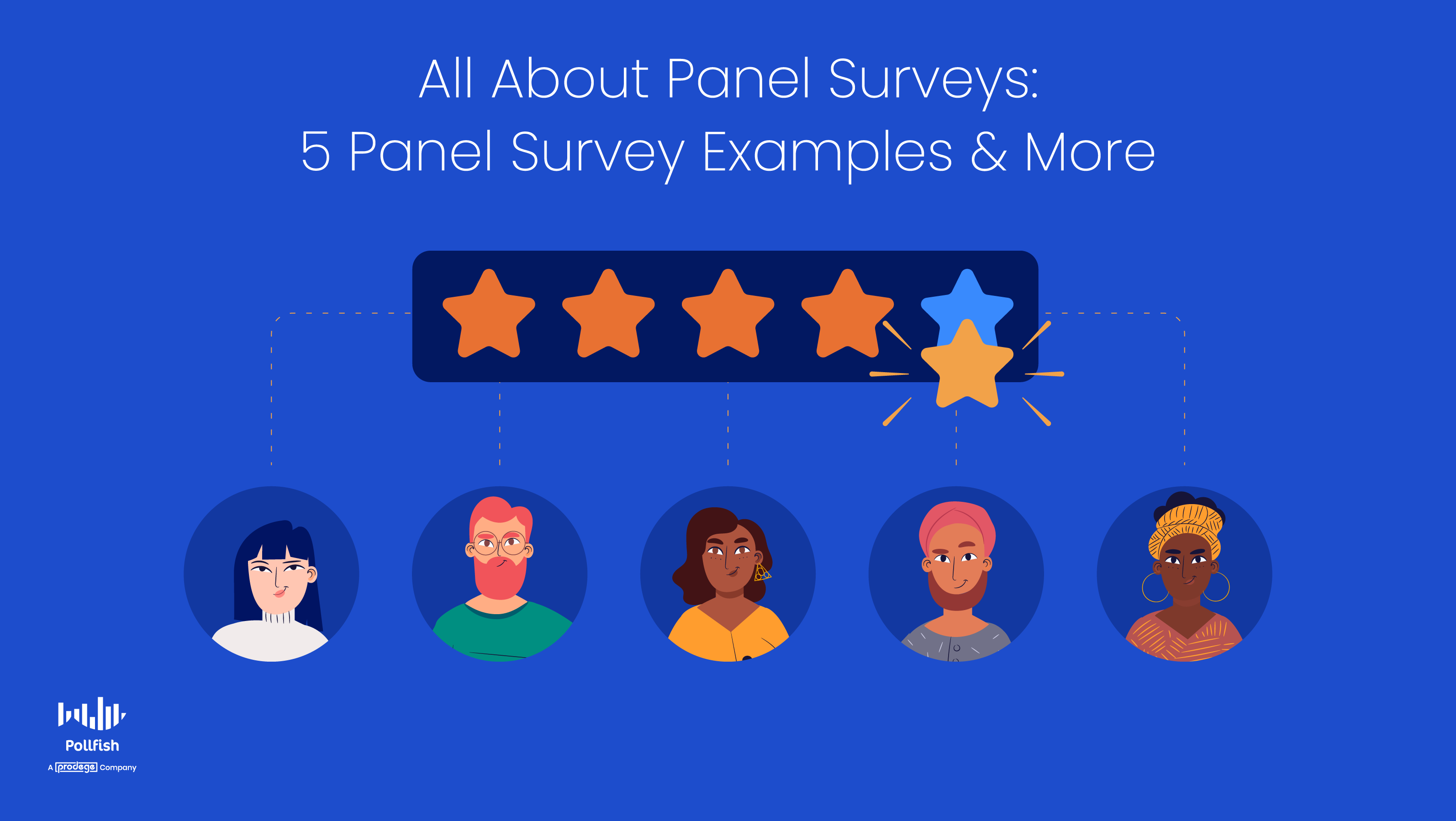
A survey panel also referred to as a panel survey, is a common research method used to gain insights from the same group of participants over a certain period.
This technique relies on examining research participants who join a market research study voluntarily. Aside from this, the participants are pre-recruited by researchers, to ensure they fit the respondent criteria they set for a particular research project.
This kind of research technique may appear to be a buzzword, given its prevalence in the market research space. However, whether it is useful and effective for your market research is entirely up to your research preferences and campaign needs.
Nonetheless, it is crucial to understand what a panel survey is before you can decide on whether you ought to implement it into your research strategy or not. Or, perhaps you want to use it in conjunction with another research method.
Either way, you should have a holistic view of everything this research method entails. This includes comparing it with random organic sampling and online surveys. Luckily, this guide provides all of this information and more.
This guide explores panel surveys, explaining them in full depth, along with their pros and cons, 5 examples of them and a comparative analysis of random sampling and survey panels.
Note: If you’re looking to do market research without the drawbacks of conducting panel surveys, try Pollfish. Our unique methodology guarantees authentic high-quality data, and it’s a fast and reliable way to survey targeted (yet randomized) people while they’re already engaged on their devices.
All About Panel Surveys: Table of Contents
- Defining Panel Surveys
- Panel Surveys: A Kind of Longitudinal Study
- Using Panelists in Your Target Market
- What to Study with a Panel Survey
- The Importance of Panel Surveys
- Panel Survey Examples: What Do Researchers Use Panels For?
- Pros & Cons: The Advantages and Drawbacks of Panel Surveys
- Organic Sampling: A Better Alternative to Panel Surveys
Defining Panel Surveys
Also called survey panels, panel surveys are a distinct form of market research that relies solely on panels to carry out the research study, as its name suggests.
Thus, it’s key to understand what the term “panel” means in the context of market research. A panel is a selection of participants who help researchers conduct market research by providing them with feedback on various studies.
The panelists do not join the study randomly, rather they are pre-recruited and pre-screened, based on the researcher’s panel needs and criteria.
A kind of research panel, a survey panel operates in the same way, except that it is strictly used within survey campaigns. As such, this panel is used for survey research alone, as opposed to other methods of panel usage.
Panels can be used in various research settings, including the following:
- One-on-one interviews
- Focus groups
- Survey studies
- All 6 main types of research, which include
- Exploratory research
- Correlational research
- Causal research
- Descriptive research
- Experimental research
- Explanatory research
- Field research
In the context of this guide, we’re going to focus on panels used in survey research alone. Hence, they are called survey panels, or panel surveys.
One of many market research techniques, this kind of research process uses a consistent group of participants, with the researchers returning to them repeatedly, either for a single survey campaign, which can require using multiple surveys or for multiple campaigns.
Panel Surveys: A Kind of Longitudinal Study
It is important to know that when referred to as a panel survey, this kind of research method is known as a longitudinal study. As such, this process is paired with longitudinal surveys.
This type of research study is often associated with correlational research.
As a type of longitudinal study, panel surveys involve correlational research because they examine the relationship between variables over an extended period. The period itself can vary.
As such, this kind of research method can be conducted in the following ways, occurring throughout:
- Weeks
- Months
- Years
- Decades
Regardless of the time dedicated to performing this research, it always involves the same survey target audience. By surveying the panelists at different points in time, researchers can glean a wide variety of changes and consistencies within their research subjects, aka the panelists.
Using Panelists in Your Target Market
While the panel remains the same, the topic(s) that can be scrutinized are virtually limitless.
For market research, the topics deal with a business’s target market. As such, all members of the panel survey must also have the qualities of those in your target market.
You can perform panel survey studies by zeroing in on your target market’s various market segments and customer personas. These are more distinct and defined groups of people who fall under your customer base.

This is the ideal way to conduct this kind of research and many others, as your target market can include a wide range of subgroups, whether they differ based on the following categories:
- Geographical locations
- Demographics
- This involves groupings based on gender, age, income level, ethnicity, employment type, education, etc.
- Psychographics
- This involves their attitudes, lifestyles, aspirations, values and other psychological criteria.
- It also involves whether they engage in a particular customer behavior.
- Firmographic
- This label is particular to studying a panel of business personnel, which you may do in B2B research.
- As such, it requires running B2B surveys.
Whichever categories you intend to group your panelists into, remember that they must fit into the qualities of your target market, as this group is the population of people most likely to purchase from your business.
What to Study with a Panel Survey
As aforementioned, you can explore a wide variety of topics in your panel survey. The following list enumerates some of these topics. Note that this is not a comprehensive list, as various other topics of concern may crop up, depending on your business, your customers and your research needs.
Here’s what this kind of research method allows you to study:
- Changing attitudes, opinions and sentiments
- Changes in customer buying behavior
- Changes in customer lifestyles
- Changes to consumer preferences
- Developments in your target market needs
- How your target market views your competitors
- The willingness of your customers to make repeat purchases
- Gaining a more in-depth glance at your market segments and customer personas
- Performing time-based research, such as longitudinal studies, retrospective studies and prospective studies
- Acquiring a snapshot of the present through cross-sectional studies
In this post, we’ll look at five-panel survey examples, which delve deeper into some of the topics on this list. But first, we’ll explain why this research method is important for researchers and their market research campaigns.
The Importance of Panel Surveys
Panel surveys are important for a variety of reasons. Some of these reasons may hold more weight than others, depending on your research needs and preferences.
Firstly, these panels are ideal for longitudinal research, as the same group of participants agreed to partake in your study. You would make it known that they would be used in continuous studies.
Aside from facilitating longitudinal studies, panel surveys are also ideal for another time-based research campaign: retrospective studies. As such, these panels aid researchers in completing their retrospective surveys.
This kind of study is used to examine changes over a long period, except the survey itself is only administered once. That’s because retrospective studies invoke occurrences from the participants’ past, whether they are experiences, inclinations, feelings, or attitudes.
The study may ask participants to compare past phenomena with how they feel in the present. The purpose is to study historical data and compare it with the present.
Panel surveys are also necessary for prospective studies, which also can last for years and study changes and developments. However, unlike retrospective studies, they involve participants who do not have a certain outcome. Instead, prospective studies seek to study people before they develop a certain outcome, such as a disease or a new shopping habit.
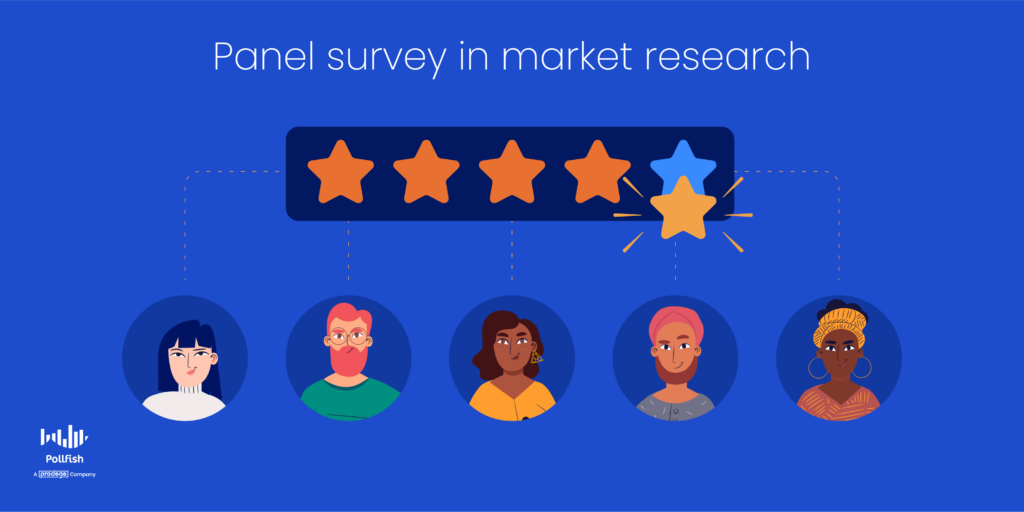
Aside from enabling researchers to study changes, these panels also make it possible to conduct cross-sectional studies, which are different from the prior three kinds of research studies — longitudinal, retrospective and prospective studies. Nonetheless, cross-sectional studies are still one of the key survey research methods.
As opposed to studying survey subjects at multiple points in time, a cross-sectional study entails gathering research about a particular population at one fixed point in time. Because of this, this type of research method is often referred to as a snapshot of a studied population.
This kind of study is conducted by using cross-sectional surveys, which are designed specifically for the cross-sectional model and can be sent to your panelists. Although cross-sectional studies don’t require a panel survey, given that they focus on a single point in time instead of several to examine changes, they can still be administered via these panels.
That’s because you can recruit panels for virtually any study, whether it includes partaking in a survey, an in-person interview, field research, or a focus group. Thus, panel surveys are not limited to any form of study, making them multifunctional.
This grants plenty of convenience to researchers, especially those bogged down by various other tasks they have to uphold, instead of putting together a group of respondents.
Panel surveys are especially important, as they provide an ongoing sampling pool of participants, which researchers can turn to whenever they seek to conduct more research. This can be to jump-start a new research campaign or conduct further research for an ongoing campaign.
This constant access to a sampling pool can also assist researchers who initially thought they had enough data, only to later discover they need more information. After all, if the panelists have already opted in, there is no need to seek out participants any further.
Panel surveys are also useful due to the quality of the panelists. Although identifying and vetting panel members may take some time, the result is a quality survey panel, one that ticks off all the panelist criteria you have. With this, you can mitigate fraud and rest assured you’re studying the correct populations.
All in all, panel surveys are useful for a variety of market research campaigns and come with a good share of benefits, despite some of their shortcomings.
Panel Survey Examples: What Do Researchers Use Panels For?
Now, let’s get to the heart of these panels, by going over what they can consist of, when, where, and how to use them.
The best way to explain the uses of a panel survey is by providing several panel survey examples. In this section, we’ll review five examples of when panel surveys can be used to good effect.
This will allow you to understand how panels work, along with some of their best-case scenarios for usage.
Example #1: Tracking Changes Over Time
Given that studying changes over time is the main purpose of leveraging a survey panel, it’s key to review this use case.
As such, one of the strongest examples of a panel survey is when researchers ask the same question(s) to a group of the same participants over a long period.
For example, if you were conducting a sociological experiment to understand if (or how) age correlates with wealth, you can set up a survey that studies panelists on the following:
- Income
- Expenses
- Assets
- Changes in employment
- Willingness to change jobs
- Willingness to switch job fields
A survey covering this topic ought to be conducted every two years, possibly spanning a decade (or more if need be).
That way, you can track changes relative to the scope of the issue you’re researching. Given that people typically stay at a job for about two years, it is key to follow up every two years on this research subject.
However, this has changed due to the Great Resignation, which saw the largest exodus of employees quitting their jobs in recent history.
The Great Resignation is not slowing down any time soon, with large numbers of people seeking better pay and benefits, along with the rise in job openings and remote work. This makes it much easier to switch jobs.
As such, the length of time you devote to tracking changes will depend on the circumstances of your study.
Alternatively, if you run a business, you’ll need to acquire ongoing insights into the market – and into audience behavior. For example, if your gym wear company wants to track the fitness habits of people over the year, a panel can be questioned every three months. You can run surveys with the same questions about how long people exercise, where they exercise, and how they do so.
For any business endeavor, you can implement the brand tracking survey, which allows you to track any changes that deal with your brand. This involves studying how your business is perceived, how in-demand its offerings are, what concerns your target market has that your business can address and much more.
Example #2: User Experience Research
Another common example of using a panel survey is for UX and UI design research. While UI refers specifically to designing web experiences, UX is far broader.
User experience can refer to a wide range of experiences that your customers encounter when interacting with a product, digital experience, or service. As such, it covers a wide range of aspects, all of which have some impact on how users experience your business’s offerings.
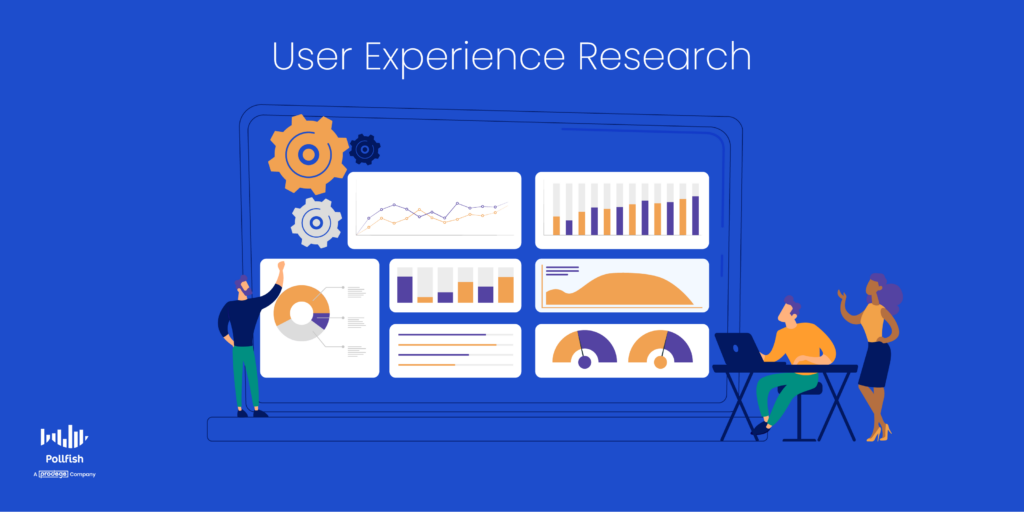
You can use these aspects as key considerations for driving your UX research. The following lists the four key components of user experience, which you should use in your research:
- Value: Does this experience give customers value?
- You can ask your panel whether a certain product, service, or digital experience provides them use and how so.
- It is key to study how your offerings can be made more valuable.
- Also, you should inquire about the products/services that your customers don’t find useful.
- Function: Does a product or product feature work?
- Ask your panel whether there are any bugs or glitches in how a product, feature, or service works.
- You can also study whether new needs arise in terms of your product’s functionalities.
- Usability: Is it easy to use?
- While your offerings may provide value, ask your customers whether they are easy to use, regularly.
- Study if your offerings can be made simpler over time.
- Also, look into whether customers seek other ways to access your offerings.
- For example: different devices, operating systems, web and app access
- General impression: Is it pleasant to use?
- Track changes to the overall sentiment towards your products, services and business at large.
- Ask your customers whether your offerings delight them or upset them.
- Ask customers to reveal anything else they’d like to see from your business to improve their UX.
When a company is building an app or a digital product, they want to gauge the customer experience as they go.
While usability testing (i.e. tracking how a person interacts with a specific feature), is often done using different methods, you can conduct qualitative research about design and experience by way of panel surveys.
The benefit of a panel survey here is that the participants remain constant – which removes a key variable.
Additionally, you can select panel participants based on their background or expertise, which will allow your pool to answer questions in a way that adds value to your product development process.
Example #3: Customer Satisfaction Surveys
Customer satisfaction is central to keeping your business alive, whether you want to release new products or build a steady base of loyal customers. As such, you can use panels to keep a watchful eye on your customers' satisfaction with your business.
Doing so will allow you to increase your customer lifetime value, a metric that measures the total monetary value a customer will bring to a business during their relationship with the business throughout their lifetime.
If you want to gauge customer satisfaction and positive/negative sentiment over the lifetime of their interactions with your offering, use a select group of long-term customers and ask them questions periodically about your value proposition.

Use a customer satisfaction survey for this campaign, which can be framed to reveal hidden sentiments, or can be explicitly focused on asking how satisfied they are with what you offer.
For example, use the following questions/considerations to measure customer satisfaction:
- On a scale of 1-10, how satisfied are you with [a product, service, experience]?
- A rating scale question
- What would you change about [a product, service, experience, or your company] if you could?
- Open-ended question
- How easy was it for you to [do something] with our product?
- Options include a scale of extremely easy to extremely difficult
- This is a Likert scale question,
- How would you rate your experience with our new [a product, service, experience]]?
- This can be a Likert scale.
- Or, it can involve multiple choices of varying answers.
In this panel survey example, the business would be able to track patterns of customer happiness over time – for example, to see whether features continue to add value months or years after the customer signs up. And you can incentivize participation with gifts, reduced subscription fees, or extra services.
Consider discussing the following topics with your panel:
- What are their overall thoughts about your business?
- How do they receive product updates? (Poorly, well, etc.)
- What kind of value does your business provide and where does it lack in value?
- What else can you do to delight your customers?
Example #4: Employee Engagement
Another crucial panel survey example deals with studying your human capital, aka, your employees. After all, it is the employees that allow your business to function daily.
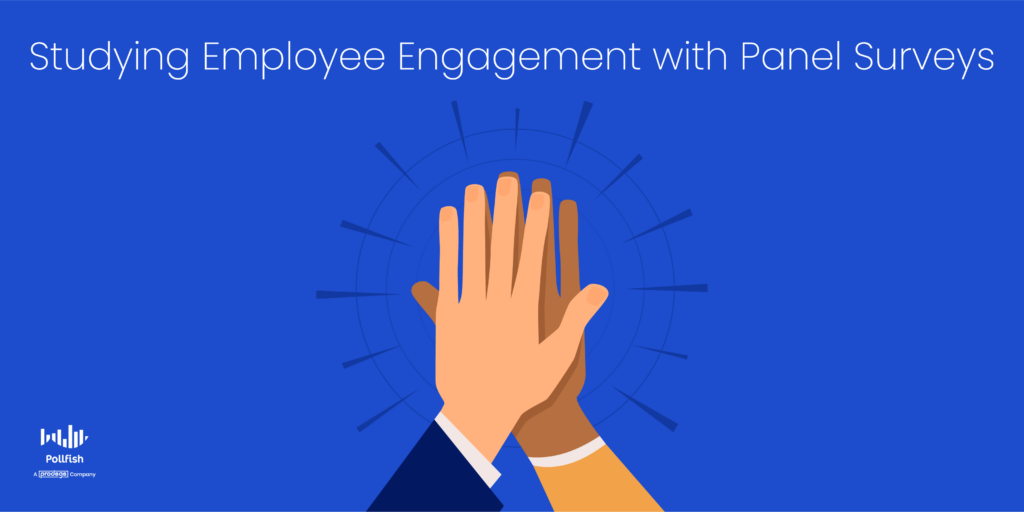
As such, your business needs to track employee engagement and team morale. In essence, here, your staff are the members of the panel survey – and you might survey them every week, month, quarter, or year. In this case, you’re surveying the same people about issues that answer the following:
- Are employees engaged at work, or do they have low morale?
- Do employees enjoy their work?
- Are they meeting their goals?
- Do they understand the company's mission?
- Do they understand the company roadmap and high-level goals for the coming weeks and quarters?
- Are they happy with their compensation?
- Where can the company improve?
If this is the type of panel survey you’re looking for, there are plenty of surveys that are specialized for human resources and employee engagement purposes.
This includes the following surveys:
- The employee satisfaction survey
- Used specifically to measure satisfaction, this survey focuses on what customers like and dislike about their jobs and the company,
- The employee feedback survey
- This is a general survey that should handle high-level topics.
- The employee burnout survey
- This survey focuses on the negative aspects of employees’ jobs and your company.
- You can use it to avoid burnout by asking them what they’d like to see change in their employment, workflows, job processes, schedules, etc.
- The employee recognition survey
- This is conducted to measure and understand the degree of employee recognition within a business.
- It gauges the perception of recognition that employees feel they have from their managers, peers and the company at large.
- The eNPS survey
- This functions the same way as a Net Promoter Score survey but for employees.
- Employees are asked how likely they are to recommend their company to others, on a scale of 1-10.
- The employee retention survey
- This is used as an instrument to retain employees.
- It delves into the topics that business owners and HR workers need to understand, to forge ideal work environments and cater to the needs of their employees,
Example #5: Customer Loyalty
It takes years to build solid consumer loyalty, which is a must, given that it is the core of the aforementioned customer lifetime value. By retaining your customers, you’ll spend less on attempting to acquire new ones, have a steady pool of revenue and maintain a good brand reputation.
Your panel survey can help you keep track of your customer loyalty. As you gain their insights, you’ll discover how you can raise their loyalty to your brand. To do so, use a market research platform that offers a brand tracker.
This tool allows you to keep track of a variety of brand issues throughout the year and beyond. It enables you to uncover whether there are any shafts in your brand perception or reactions to your marketing campaigns.
Consider tracking the following on customer loyalty:
- What excites my target market about your offerings?
- What kind of brand news incites the most interest?
- Which segments of customers are most likely to make repeat purchases?
- Which customer groups are the most loyal to your brand?
- Which actions and offerings inspire loyalty to your brand?
Pros & Cons: The Advantages and Drawbacks of Panel Surveys
Now, it’s time to analyze the advantages and disadvantages of using panel surveys for your market research.
One of the primary advantages of a panel survey is that the participants learn to trust the researchers, and therefore may be open to deeper and more truthful answers.
In addition, this ongoing relationship can allow researchers to dig deeper with follow-up questions.
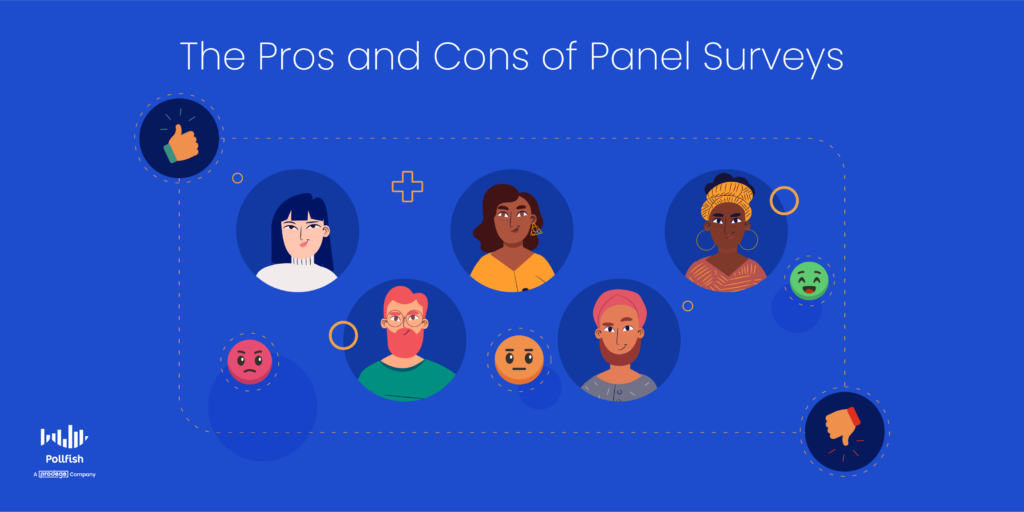
Another advantage is that with screening having occurred at the start of the research, all following surveys are quicker to carry out than starting from scratch.
However, the disadvantages of panel surveys include:
- Panel conditioning: When you’re surveying the same people repeatedly, previous surveys might influence their responses and/or behavior. For example, if they know a certain question triggers a longer process, they may choose an answer that offers the path of least resistance. Or if you’re asking about a particular activity, like eating donuts, they may eat less (or more) thereafter.
Note: Furthermore, panel surveys don’t tend to occur within a “natural” setting, and therefore the artificial environment might affect thought processes and responses to questions. - Panel fatigue: If a person feels like a pay-off for participating in a panel survey is no longer worth the effort, the quality of their response may drop. This leads to incomplete or poor-quality survey responses, and survey “straight-lining” – i.e. answering the same to every question.
- Declining participation: Over time, inevitably, participants will drop out of the process – either due to panel fatigue, or other reasons. This will damage the quality and depth of your data.
And with survey panels, you run the risk of accidentally signing up “professional” panelists – especially when there are cash-based incentives on offer. Though screening should be designed to pick up these people before they enter the process, they’re adept at slipping through the net.
Organic Sampling: A Better Alternative to Panel Surveys
With increased pressure on people’s time, survey response rates have been decreasing. It’s harder than ever to guarantee consistent high-quality data, and as conventional survey companies scramble to include as many willing participants as possible, the quality reduces yet further.
At Pollfish, we don’t use conventional panels. Our unique methodology, called Random Device Engagement (RDE) uses the organic sampling approach for finding and procuring survey participants.
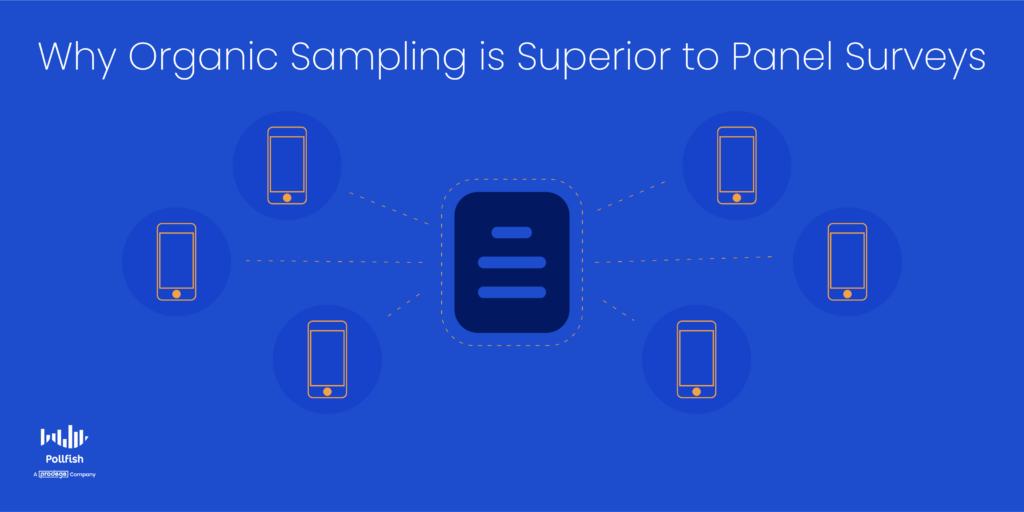
A kind of organic probability sampling, RDE polling relies on advertising networks and other device portals to engage potential respondents wherever they are voluntarily. This includes a variety of digital platforms and properties, such as:
- Mobile sites
- Apps
- Website
- Mobile games
All respondents gathered via the RDE method have no biases, as they are not pre-recruited and therefore face less pressure to answer things in a certain way. Due to this, they are less subject to a wide host of survey biases.
This includes the following survey biases:
- Sampling bias: This bias occurs when the respondent selection process, specifically when a survey sample is not chosen at random.
- This leads to under or overrepresentation of a certain segment of your survey target population, as only certain types of respondents are going to partake, while others aren’t.
- Acquiesce bias: Also called agreement bias, this occurs when respondents gravitate towards positive or agreeable answers.
- In this bias, respondents feel more social pressure to answer in a particular way, as their identities are known in panel surveys.
Organic sampling and Random Device Engagement obliterate these two (and other) biases. That’s because this process is completely randomized, stamping out sampling bias. Not only does it reach people randomly, but on Pollfish, this method is paired with our state-of-the-art survey platform.
Our online survey platform reaches specific populations based on demographics, psychographics and specific screening questions you can input. This ensures you’ll reach all the required target audiences to partake in your study.
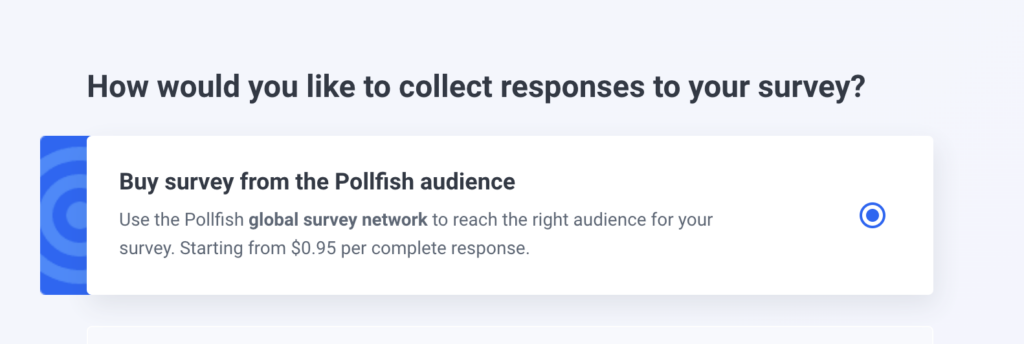
Aside from reaching respondents organically and randomly, the respondents are completely anonymous. They don’t need to provide their names, contact information, or any identification to take a survey. Instead, they are simply reached and opted in.
They may also have the option of gaining survey incentives. This eliminates virtually all forms of acquiescence bias, as there is no pressure to provide certain answers over others.
Each screened participant has a unique ID, which prevents them from taking the same survey more than once, weeding out bias and survey fraud.
When working with Pollfish, you don’t need to use conventional panels – which are slow and subject to conditioning, fatigue, and declining participation. Instead, get authentic insights from our pool of over 250 million people (and growing) – who are already engaged on their devices and ready to participate.
As such, organic sampling, coupled with a potent online survey platform like Pollfish, provides a better market research option over panel surveys.
A panel survey is a type of survey method that involves repeated interviews of a group of people over a specific period of time. A longitudinal study is another term used to describe panel survey. It refers to any study that examines the same group of people over a period of time. Panel participants often learn to trust the researcher and may reveal deeper, most honest insights. This type of survey is also a good way to track progress or evolution over time. Panel fatigue occurs when the participant no longer feels that the reward for participating in the panel is worth it. If panel fatigue occurs, the participant may not give deep answers, but instead try to answer the questions as quickly as possible. When interviewing the same people repeatedly, the answers to previous surveys may influence their behavior by causing them to reflect on activities that they previously gave little thought to. This influence is known as panel conditioning.Frequently asked questions
What is a panel survey?
What is a longitudinal study?
What are the benefits of panel surveys?
What is panel fatigue?
How can panel surveys influence participant behavior?
Tapping Into Consumer Research Hacks for Your Market Research Campaigns
Tapping Into Consumer Research Hacks for Your Market Research Campaigns

In today’s digital, mobile-first age where brands are jockeying for customers’ patronage and attention, brands need to conduct consumer research to understand them. This way, they can align themselves with their consumers and excel at serving all of their consumers’ needs.
81% of consumers buy based on their trust in a brand and 77% of consumers buy from brands that share the same values as they do. Clearly, there is much to consumers that businesses must stay aware of, with values and brand trust making up just two of these matters.
However, despite the importance of this kind of research, less than 40% of marketers use consumer research to drive business decisions. This is a problem for various evident reasons, the most important one being the lack of key insights on the population of people who purchase from you.
Many brands simply don’t know how to conduct proper consumer research or don’t have the time to learn how.
This article delves into consumer research, its importance and four key hacks on conducting it to reap quality consumer intelligence.
Understanding Consumer Research
Although consumer research largely makes up the bulk of market research, the two are distinct concepts and shouldn't be mistaken for one another.
Whereas market research is the all-encompassing practice of studying customers, consumer research is a part of market research that focuses on customer behavior, specifically customer inclinations, motivations and customer buying behavior. In this kind of research, businesses identify these aspects within their target market as a means of studying the psychology behind their customers.
The results of this kind of research allow businesses and organizations to understand their customers on a more granular level. By doing so, they can then create detailed purchasing behavior profiles which they can use to inform all of their marketing campaigns.
There are a variety of consumer research methods to gather this information, which include the overarching approaches of market research techniques. Businesses can use these methods to gain deeper consumer insights, essentially learning about their customers beyond their demographics, location and other outward traits.
Although there are no set-in-stone rules for conducting consumer research, there are several approaches, or hacks you ought to take to hone in on your studies.
This way, you will be able to create well-targeted campaigns on specific consumer segments.
The Importance of Conducting Consumer Research
It’s important to conduct consumer research for a number of reasons.
Consumer research grants you insight into the minds, behaviors, actions and other aspects of the people most inclined to buy from you: your target market. In turn, you’ll have access to in-depth information about your consumers’ desires, needs, expectations and more.
Most importantly, you’ll have access to insights that reveal the “why” behind these phenomena, meaning, you’ll understand the motivations, tendencies and other thought processes that cause your consumers to think and behave in the way that they do.
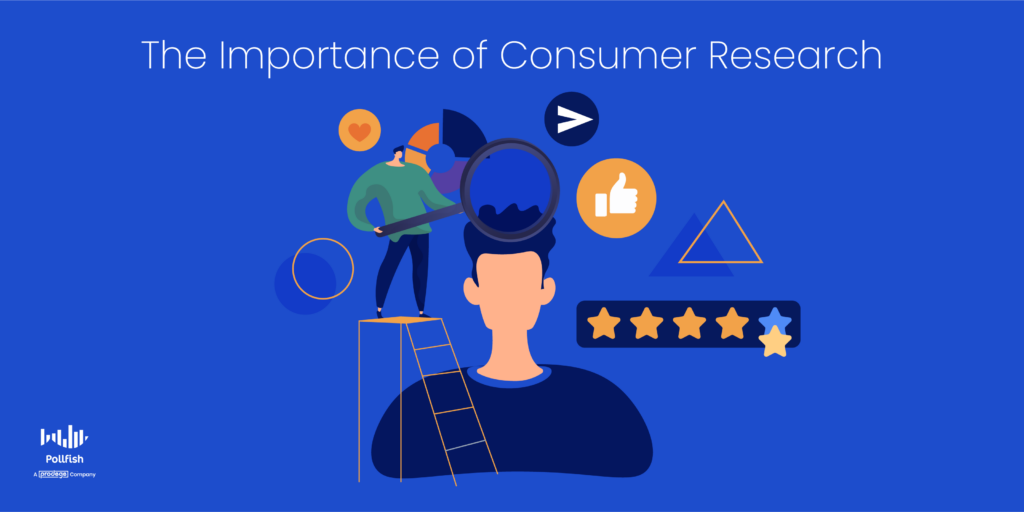
As such, consumer research provides granular customer intelligence, the kind that allows you to tap into consumer mindsets.
By obtaining this kind of information, businesses can craft tailored marketing personalization and a host of other marketing strategies, including those that make up the strategic planning process.
Unlike strategies and campaigns built on intuition or secondary market research alone, those conducted via primary consumer research provide quality data for decision making — and not just any data that you can easily extract from online sources, but data that is unique, timely and most relevant to your particular target market.
In turn, businesses will be able to form campaigns that don’t merely win over existing customers, but acquire new ones. When you are able to successfully acquire new customers by understanding them on a deeper level, you’ll be able to lower your customer acquisition cost.
By understanding what customers want and how they think, you’ll establish a customer-centric brand in practice as opposed to in theory alone.
You’ll thereby increase your customer satisfaction and keep your brand relevant. As such, you’ll be poised to retain your customers, which is a stronger long-term strategy in comparison to acquiring new customers. This will allow you to increase your customer retention rate, keeping a steady source of customers and the profits they yield.
All in all, consumer research provides the necessary intelligence to win over customers, build consumer loyalty and retain customers, as well as boost your business overall.
Consumer Research Hacks
As aforementioned, there is no hard and fast rule when it comes to conducting consumer research. No technique or set of techniques is set in stone. As a marketer, business owner or market researcher, it is up to you to settle on the methods of running consumer research.
This can be difficult to execute, as there are so many tools and sources available, from secondary sources such as statistics websites and trade magazines, to primary methods such as using a focus group or types of consumer surveys.
Aside from research sources, there are also different research approaches, market research campaigns and types of research you can conduct to learn about the psychology behind your customers. To wade the seemingly difficult waters of consumer research, we’ve laid out four major hacks for conducting consumer research.
The following explains these hacks:
Hack 1: Decide on the Broader Campaign
While there are going to be times in which you simply need to learn how your target market ticks in terms of its consumer preferences and behaviors. However, most of the time, your curiosities about your consumers will not be for stand-alone affairs.
Instead, you may need to collect some in-depth information on how consumers would react to a certain advertisement. You may want to see how they receive emotional marketing, as personality types within your target market will vary.
As such, you should first find the anchoring campaign behind your consumer research. Perhaps it is for a campaign that is already currently running, such as an ad campaign you’d like to A/B test.
Or perhaps, before you embark on another marketing campaign, you seek to gain consumer insights before running it at all. For example, a campaign with a new theme and you need to discover how your customers feel about it.
Come up with your questions or the subject of the questions, at the very least, to guide you and tether your research to a broader business campaign.
Hack 2: Determine the Length and Duration of Your Study
After you tie your consumer research endeavor to an existing or new campaign or undertaking, determine the length and duration of your study. This involves choosing to run another major type of sub-campaign of market research, as certain studies are organized due to their time dependence.
For example, for longer-term consumer research, you may need to conduct longitudinal studies, which aim to gather data on the same set of respondents over a longer period of time. This can last between months and decades.
For short-term consumer research, you may want to conduct cross-sectional studies, in which researchers gather research on a targeted population at one fixed point in time. This type of survey research method is known as being a snapshot of a studied population.
Perhaps you’re interested in studying your consumers’ past habits and experiences. For such a study, you would need to form a retrospective study. Such a study is useful for observing the changes your consumers have undergone, along with picking up on patterns.
Hack 3: Conducting Market Segmentation
The makeup of a target market can be vast, no matter how niche your company and product(s) are. From different age groups, to behavioral aspects, your target market is not composed of a single entity. Rather, it is made up of smaller groups, known as market segments.
It is crucial to conduct market segmentation when executing your consumer research project. This way, you’ll be able to identify the various market segments making up your target market and target them accordingly. Additionally, you ought to segment your target market even further by organizing your segments into customer personas.
These are fictional characters that represent real people in your market segments, except they contain traits that are far more specific than that of a market segment. Personas usually include hobbies and lifestyle aspects. You can then label your different customers by their relation and fit with your personas. Personas allow you to make your messaging even more targeted and satisfy various personalities.
Hack 4: Use a Mixed Style and Multi-Pronged Research Approach
A multi-pronged approach when it comes to conducting and analyzing your consumer research involves using a strong online market research platform. Such a platform should allow you to conduct research via a number of survey types and question formats.
The platform you use should also offer a variety of options for filtering data that you collected, so that it is easy to view and parse. As such, a mixed style involves running multiple kinds of surveys to multiple audiences and relying on numerous kinds of data visualizations.
Variety is important, as different team members aren’t all going to favor the same method of collecting or viewing data. As such, a market research platform that offers a multi-pronged approach to collecting, viewing, exporting and analyzing the data fosters a culture of data democratization, allowing all members of your team to easily take part in consumer research and analysis.
Using Survey Research to Tap Into Consumer Research Hacks
It can be difficult to conduct the proper consumer research with so many sources of information at your disposal. Keep in mind that many of these sources can have dubious or outdated information, rendering your research efforts worse off than they would have been had you never used them.
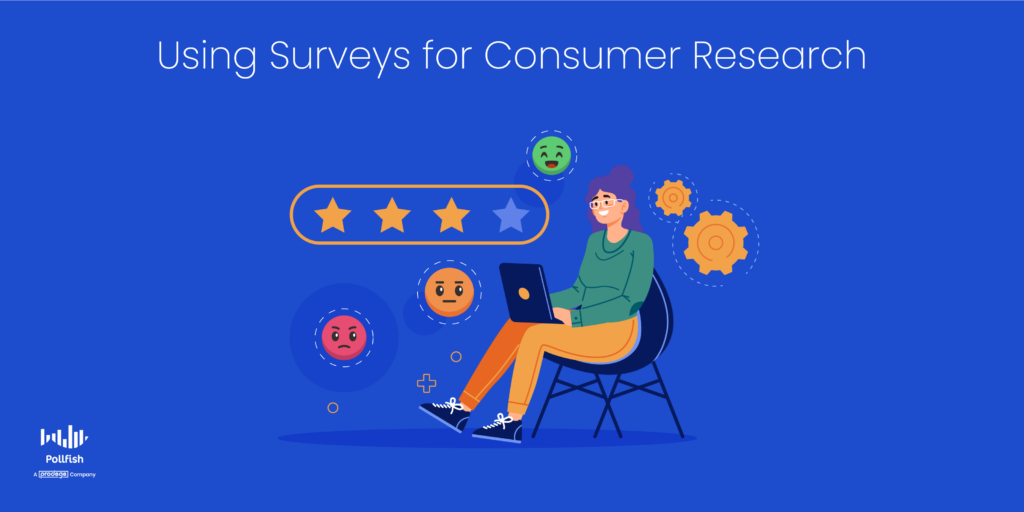
This is not just a caveat for conducting secondary research via online and offline sources, as certain market research techniques, such as using syndicated research can also be faulty. Although syndicated research can provide you with fresh and original research, it is at the helm of the market research firm conducting the study. Therefore, the firm is in control of how the consumer research study is set up, from its duration to the types of survey questions used.
Instead, you should conduct your own consumer research by using an online survey platform that facilitates the process of creating a DIY survey. Given that online surveys are one of the fastest, affordable and most reliable methods of conducting research, you’d be remiss not to use them for conducting consumer research.
A strong online survey platform grants you quick access to your desired target market sample, extracts data quickly and disqualifies low-quality data.
Delivering the Best for Your Target Market
To deliver the best products, services and CX for your consumers, you need to understand them at a deep level. As such, their age, gender and location alone are superficial aspects in comparison to their behaviors, opinions, needs, sentiments, aversions and more.
In order to tap into all of these consumer aspects, you’ll need to conduct survey campaigns through a potent online survey platform. Such a platform should run on random device engagement (RDE) sampling, which enables you to reach consumers in their natural digital environments, instead of pre-recruiting them. This removes social pressures and will cut back on biases.
You should also use a mobile-first platform, since mobile dominates the digital space.
The platform you select should also offer artificial intelligence and machine learning to remove low-quality data, offer a broad range of survey and question types and disqualify unattentive respondents.
Most importantly, it should allow you to survey anyone. As such, you’ll need a platform with a reach to millions of consumers, along with one that offers the Distribution Link feature.
This feature will allow you to send your survey to specific customers, instead of just deploying them across a network.
When you use an online survey platform with all of these capabilities, you’ll be able to perform quality consumer research.
How to Cater to All Kinds of Consumer Preferences
How to Cater to All Kinds of Consumer Preferences
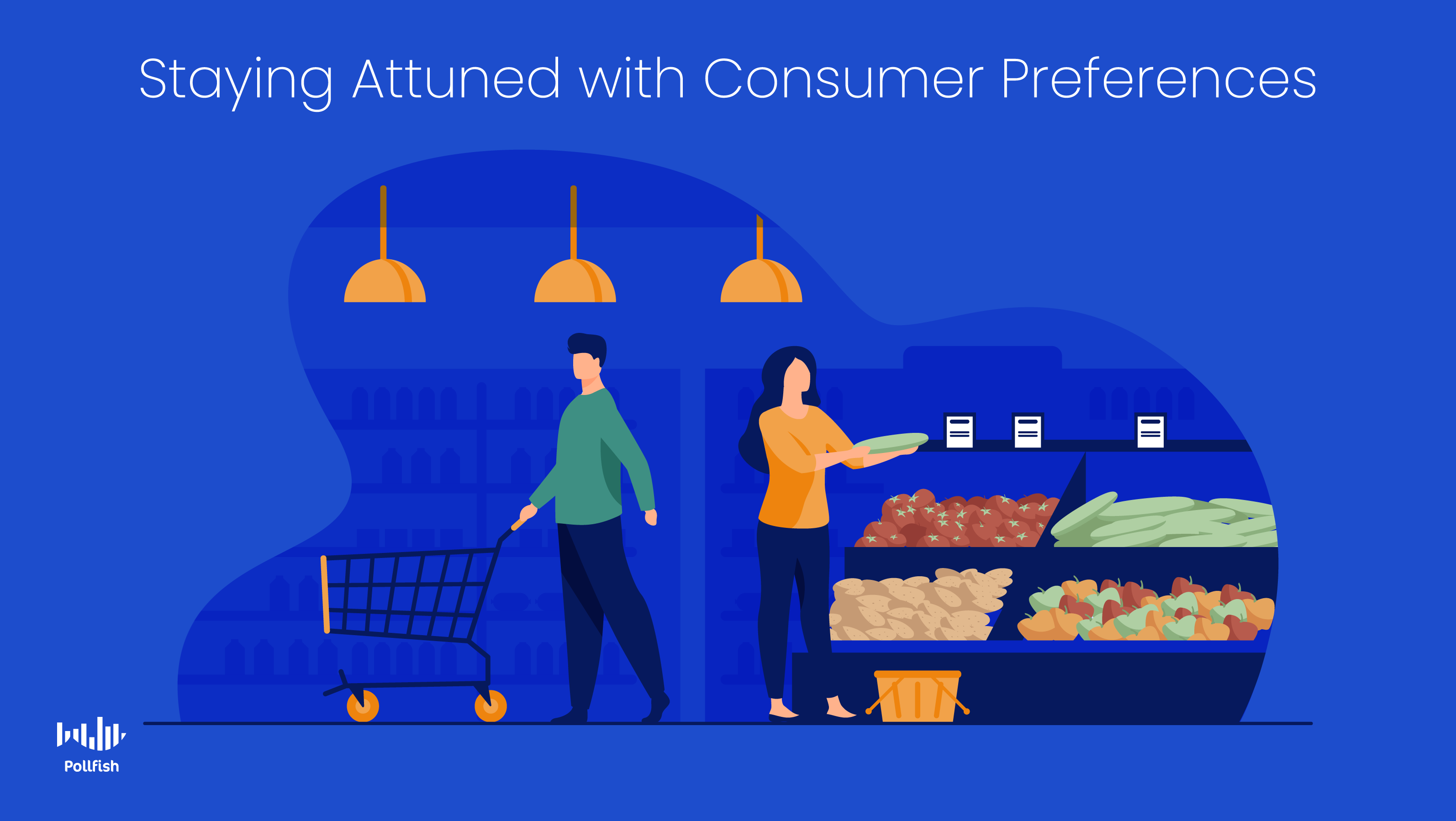
Catering to consumer preferences is an absolute must to succeed, and this requirement is even more pronounced in an omnichannel digital world, as this space has seen constant changes. Many of these changes have been and will continue being connected to the Covid-19 pandemic.
It is of the utmost importance to be attuned to your consumer preferences during this time if you seek to move past it. As expected, this period has experienced many changes in how consumers prefer to shop. For example, baby boomers, who have always almost exclusively shopped in brick-and-mortar stores, have increased their online shopping by almost 50% since the start of the pandemic.
30% of online consumers prefer using a BOPIS (Buy Online, Pickup In-Store) model or the curbside pickup option over delivery. 87% of US consumers now prefer to shop in stores with touchless or self-checkout options.
As such, no matter how well you think you may know your target market, consumer behavior, and consumer preferences, they are subject to change. This is especially compounded with the constant changes in digital and the continuation of the pandemic.
This article examines consumer preferences in their many forms, their importance, how to cater to them and how to use market research to discover them and properly serve them.
Understanding Consumer Preferences
Consumer preferences refer to a wide range of subtopics, as they relate to the tastes and fondness of consumers towards certain things over others. This can relate to many other customer concerns, such as the customer buying journey, customer buying behavior, brand loyalty, customer satisfaction.
Consumer preferences largely involve subjective individual tastes, likes and dislikes, and inclinations. When you’re working on a marketing campaign or developing a new product for your target market, you need to consider their personal preferences to reap good results.
To understand your target market’s preferences, you’ll need to understand what makes them tick as consumers. As such, you’ll need to understand the various factors making up their consumer preferences. These factors include the following concerns:
- Consumer motivations
- The distribution channels they tend to buy from the most
- What drives them to make one purchase over another
- This can involve price, convenience, product features, quality, causes supported by a brand,
- The values that matter to them
- How they prefer to spend their time
- Their customer experience expectations and desires
- Their buying pains
These factors present important questions for marketers and business owners to answer. Fortunately, they can be easily tested by applying the correct market research techniques.
Consumer preference studies use well-developed subjective analytical tools, such as an online survey platform that connects businesses with their consumers. Businesses can construct a survey to their needs and liking, based on the capabilities of the online survey tools they use.
This includes conducting survey campaigns about various topics, concerns and needs, such as consumer desires, aversions, product performance, customer behavior, etc. These can be stand-alone studies or performed in tandem with other studies and any of the 6 main types of research.
The Importance of Consumer Preferences
The importance of consumer preferences is rather self-evident; if you satisfy your target market’s preferences, they’ll buy from you. In this main sense of this importance, businesses can gain new customers from their target market when they meet their preferences.
This can help lower your customer acquisition cost, the chief price of acquiring a new customer. This is an especially important metric to reduce, given that it costs more to gain new customers than retaining existing ones.
Tapping into your consumer preferences will also increase and maintain your customer retention rate when you abide by your customers’ preferences. As you’ll discover from many marketing sources, customer retention is more important than acquisition.
First off, as recently mentioned, it costs more to gain new customers than it does to retain current ones; but aside from this, existing customers are also more valuable. They, therefore, have a higher customer lifetime value, as they continue buying from a business. Retaining customers also builds consumer loyalty, which does not merely yield continuous profits for a business.
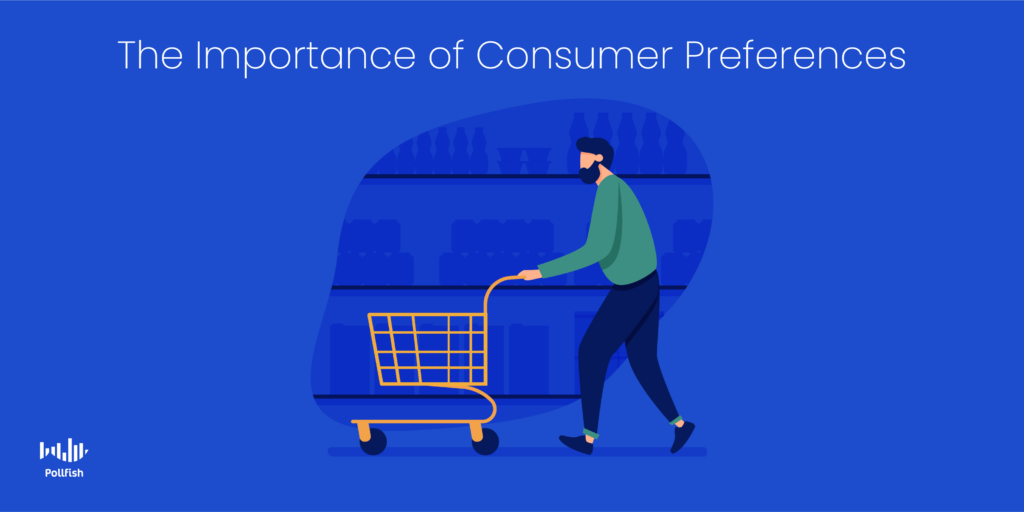
This is because happy customers will share their satisfaction with their peers, colleagues and even thousands, possibly millions, with internet users who view their reviews and testimonials. As such, it fosters each retained customer to be a brand advocate, spreading positive feedback about your business, which is essentially free marketing services.
Consumer preferences are also vastly important to stay attuned with, as they dictate virtually all of your campaigns, marketing and otherwise, except for employee-related affairs. You wouldn’t design an advertising campaign without injecting your consumers’ needs and interest in it, as it wouldn’t interest them, let alone spur them into buying from your business.
You must be well-acquainted with your consumer preferences before taking on any consumer-facing campaign; otherwise, you would be wasting a vast amount of time and resources.
Understanding their preferences provides a necessary starting point to undertake any consumer-related campaign, whether you’re launching new marketing messages or services, or simply testing your hypotheses with explanatory or exploratory research.
Finally, it is important to be acclimated to consumer preferences, as they are subject to change. Major current events, politics, opinion pieces and other media sources (think documentaries, films, books) wield the influence to change consumer preferences.
Aside from these stimuli, your competitors are also racing to fulfill their needs and their innovations and improvements may change your consumer preferences in their favor.
The 11 Kinds of Consumer Preferences
There is a vast range of matters that concern customers; as such, there are many categories of consumer preferences. Before you study any of these in relation to your consumers and create consumer-facing campaigns to show them you’re paying attention, you should know what makes up these preferences.
The following lays out the 11 main categories of consumer preferences:
- Service preferences
- This involves the style of customer service your consumers prefer. For example, some customers appreciate long, detailed explanations, while others want to be served as quickly as possible.
- You can examine these preferences with the customer service survey.
- UX preferences
- User experience involves all user interactions and experiences with a product, services, single experience and service.
- It deals with how consumers perceive the usage, utility, ease of use, and efficiency of these things.
- You can conduct a UX survey to quiz your consumer on these preferences.
- Communication preferences
- The way consumers prefer to receive information will differ from person to person.
- This involves the kinds of content consumers tend to consume, the length of the content and the method of communication.
- For example, some prefer emails, others prefer chatting, while others prefer phone calls and so on.
- As far as content is concerned, some consumers may prefer technical language and formal speech; others may lean towards a storytelling angle or towards
- emotional marketing.
- There are various consumer surveys you can conduct to better understand this kind of preference.
- Convenience preferences
- Convenience plays a major role in customer buying behavior and may influence particular customer segments more than others.
- This preference involves various components that add to making customers’ experience easier, such as fast delivery, longer customer support phone hours, brick-and-mortar shops open on the weekends, etc.
- You can understand consumer convenience preferences by running all kinds of consumer surveys.
- Customer effort preferences
- This entails how much effort customers prefer to put into their interactions with companies.
- This can involve digital efforts, such as signing up for a newsletter, checking out items, interacting with a UI element and more.
- Conduct the customer effort score (CES) survey to assess the levels of effort your consumers have to use across your UX, digital properties and interactions with representatives.
- Repeat purchase preferences
- This involves the preferences of consumers in regards to how often they buy something, especially if it’s from the same company.
- You should study whether your consumers go for old and reliable products, or try something new. Some consumers prefer repeat purchases of the same things, others will be keen on variety.
- To understand this preference, you should conduct correlational research, as this will show you whether correlations exist between various variables and whether customers make repeated purchases.
- Time preferences
- Consumers have preferences on how to spend their time. As such, some will prefer short, sweet and to-the-point content and experiences.
- Others who are more detail-oriented and have more time to spare, will prefer to spend more time interacting with your brand.
- You can learn more about time preferences by running a CES survey or other consumer surveys.
- Sensory preferences
- These pertain to the senses, such as taste, smell, touch, sight and hearing.
- Although these preferences are especially important in particular industries, such as the food and fragrance industries, sensory information should be considered when creating various company assets and experiences, such as ad campaigns, site designs, packaging designs and more.
- Study these preferences with the customer experience survey, which you can use to delve into all kinds of CX.
- Risk preferences
- This involves how open and frequently your customers take risks, especially in regards to buying from new brands or consuming new products.
- Some customers may prefer using a prominent brand, while others may have no qualms about opting for newcomers or more under-the-radar companies.
- Run a risk assessment of your consumers with the risk aversion survey.
- Values-based preferences
- Brand purpose has become increasingly crucial to consumers when they choose one brand over another.
- As such, the degree to which a brand matches consumers’ personal stance and ethics affects whether they choose to buy from the brand.
- Perform a customer feedback survey to gain insights on whether your target market makes purchasing decisions based on values.
- CX preferences
- These preferences are even more encompassing than UX preferences, as they refer to the overall experience a customer attributes to a brand.
- This includes all the sensory experiences they undergo, their digital experience, interactions with representatives and all else in their customer buying journey.
- You can perfect your customer experience by conducting the aforementioned CX survey. This will help you avoid points of friction anywhere in your consumers’ CX.
How to Satisfy All Your Consumer Preferences with Market Research
Market research is the foremost practice for scrutinizing your consumers and satisfying them in all of your campaigns. Whether you opt for secondary or primary market research, the intelligence you’ll extract from either is invaluable to understanding your customer preferences.
It’ll inform you on how to make smarter business decisions, the kinds that delight your consumers, thereby driving higher ROIs.
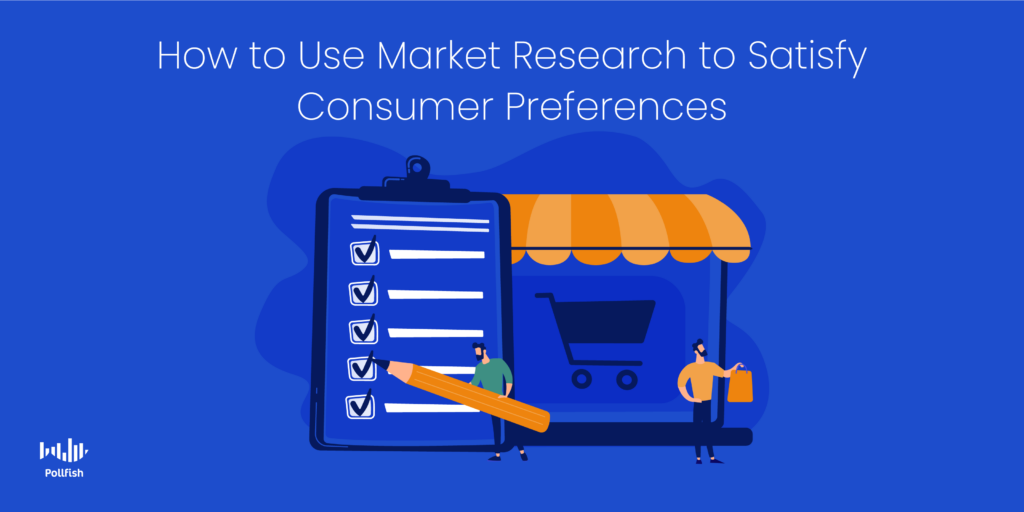
However, while both forms of research are important, it is primary research that allows you to answer questions and concerns specific to your business and target market. It also grants you unique insights, especially if you opt for the custom research approach, as opposed to relying on syndicated research, in which a third-party researcher owns and dictates research results.
First off, you’ll need to understand the makeup of your consumer base. To do so, you’ll need to conduct market segmentation, which allows you to properly organize distinct groups of people making up your target market.
This practice also helps you delve deeper by forming customer personas, fictional characters that represent unique individuals, based on traits beyond demographics and location. Both of these practices of segmenting your consumers are a must, as you’ll need to know who they are before studying the specific preferences of each.
In short, segmentation allows you to better determine consumer preferences, by categorizing your consumers into distinct groups and allocating preferences to each. This will make your market research and its ensuing marketing activities that much more focused and granular, as you can target segments, as opposed to an entire target market sample.
After you’ve narrowed down your target market into segments and customer personas, you ought to study the preferences of each. To do so, you’ll need a robust online survey platform; this tool will allow you to extract all the consumer research you’ll need to master catering to consumer preferences.
As the previous section about the 11 kinds of consumer preferences shows, you can pair surveys with your study of any of those preferences. You can use general business surveys or consumer surveys for certain consumer preferences, while others will require surveys specific to a campaign or aspect of CX, such as the CES survey.
Taking Your Research to the Next Level
To cater to the subjective nature of consumer preferences, you’ll need to use a high-performing provider of market research. Given that online surveys allow you to access the minds of customers quickly and efficiently, the online survey platform you choose is of utmost importance.
For quality research on consumer preferences, opt for a survey tool that runs on random device engagement (RDE) sampling, as this will enable you to reach respondents in their natural digital environments, in turn reducing all kinds of survey bias.
You should also implement an online survey platform that implements artificial intelligence and machine learning to disqualify survey fraud and poor-quality data and provides a mobile-first approach design.
An online survey provider with these functionalities and more will allow you to effortlessly execute all your market research campaigns, making it easy to tackle consumer preferences.
How to Survey Your Audience with a Market Research Platform
How to Survey Your Audience with a Market Research Platform
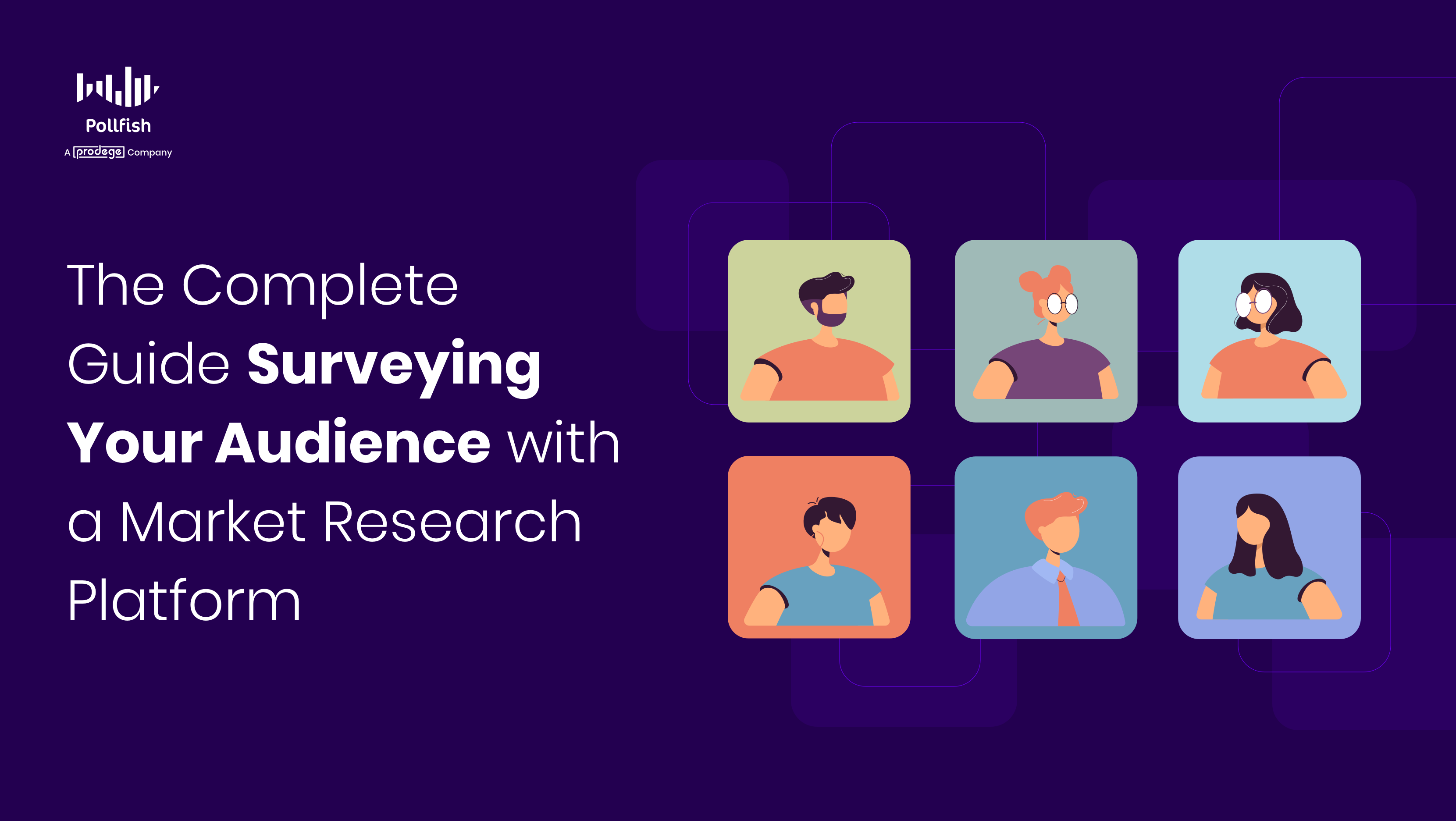 Any research endeavor will leave you wondering how to survey your audience properly so that you can collect quality data from the correct survey subjects.
Any research endeavor will leave you wondering how to survey your audience properly so that you can collect quality data from the correct survey subjects.
While surveying your audience shouldn't be a daunting chore, it should also not be brushed aside as something requiring little to no thought or structure. Instead, a quality survey campaign requires taking certain actions to ensure you’re studying the survey audience you need, with the correct questions and more.
Online surveys provide the strongest conduit to your target market, a must when conducting market research. In fact, one of the top reasons businesses fail is because they don’t invest in their target market.
This article explains how to survey your audience, including the major aspects to pay attention to and advice on how to achieve your survey campaign goals.
The Major Aspects to Observe When You Survey Your Audience
There are a few chief considerations to consider when surveying your audience. A few of them were mentioned in the intro of this article. But there are several others that are key to work towards when setting up any survey campaign.
The following major aspects show how to survey your audience:
- Targeting the correct survey audience
- Setting the purpose of the survey campaign
- The best time to send a survey
- How to set up your questionnaire
- How to incentivize your respondents
The following section will explain how to survey your audience while keeping these considerations in mind and working towards a campaign that includes all of them.
How to Survey Your Audience
Let’s take an in-depth look at how to survey your audience via the five major aspects identified above. These provide the makeup of any survey campaign.
Reaching Out to the Correct Survey Audience
First, you’ll need to reach out to the correct survey audience. You’ll need to understand who your target market is, and for this, you ought to conduct secondary research. Refer to all the available information on your industry, your specific niche, its customers, its peak sales periods and more.
There is a vast amount of information available online. You can learn more about the different market research techniques and how to perform them.
To understand your target market, you should also consolidate your secondary market research with your own internal documentation. Do you have any customer audits or documents on customer personas?
If not, you should consider creating them by conducting survey research. Surveys allow you to understand the makeup of your customers via market segmentation. The right online survey platform will allow you to target your customers in a granular way, as it will enable you to filter your survey audience through a variety of demographics and add screening questions.
Setting the Purpose of the Survey Campaign
Next, you’ll need to set the purpose of the campaign, if you haven’t done so already when you’ve decided on running a survey campaign. In the realm of market research, it is best to tie your campaign to a particular business goal.
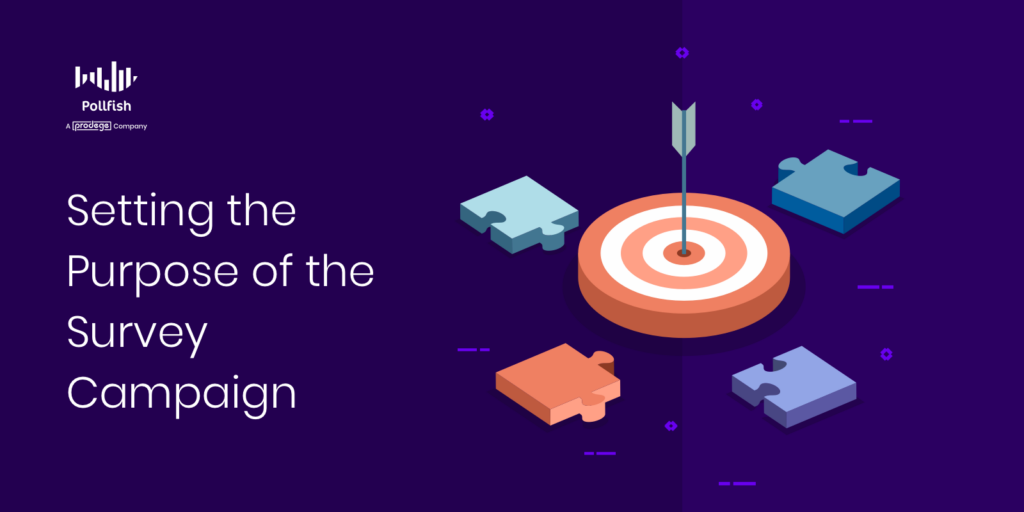
For example, do you need survey insights to strengthen your content marketing strategy? Or, do you need more insights onto who your target market consists of? You may also need to run a campaign to A/B test your advertising. The insights surveys derive are virtually limitless, so you’ll be able to use them for a variety of business matters.
Whatever the case may be, you’ll need to have an overarching campaign or particular goal under which you’ll set up your survey research. This will help you form a well-organized survey and help you put together your questionnaire.
To do so, ask yourself, what is it that you’re looking to gain from the survey and how can it help immediate business needs. Use the following characterization of survey insights to form the basis of your survey campaign:
- Validation of an idea, product or campaign
- New ideas
- Feedback
- User insights
The Best Time to Send a Survey
After you’ve targetted your survey audience, contemplate when you would like to send it.
But first, in order to determine the right time to deploy your survey across a wide network, or by sending the link via specific digital channels, you’ll need to consider the following:
- The point of your survey campaign
- Whether it is tied to other sub-campaigns
- The target audience of the campaign and their habits
- For example, you would target different times to send a survey to the unemployed younger generation, than you would to parents who work a full-time job.
After you’ve consolidated all of these matters, you ought to infer when the best time to send your survey is for different demographics of people. If you seek to send your survey abroad, consider the difference in time.
For example, Monday at 6: 30 PM may be a good time to send surveys to younger, unemployed individuals who enjoy playing video games. But Monday, at 6:30 PM in New York, isn’t the same time in other parts of the world, and even the country.
If you need more help on deciding the best time to send your survey, click on the link to the best time to send a survey, which you’ll find in the “Major Aspects to Observe” section above.
How to Set up Your Questionnaire
There are various routes you can take when it comes to setting up your questionnaire. First, consider the larger campaign or purpose of your survey. Then, consider the curiosities you have and the insights you’ll need.
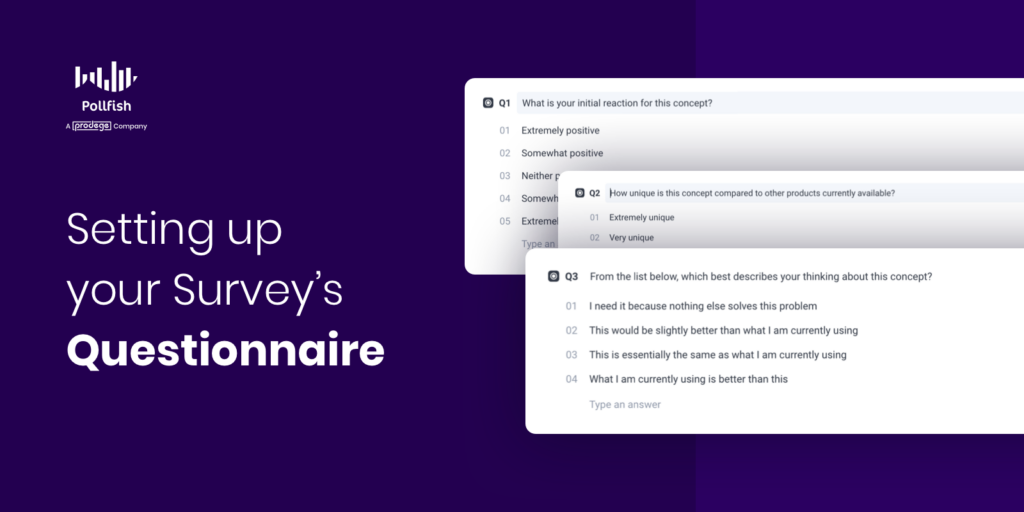
If there are too many, it is apt to separate the survey into two or more surveys. This is a general best practice for surveys, as no one enjoys filling out long questionnaires.
Then, choose from the following approaches for creating your questionnaire:
- Coming up with your own preliminary questions
- Using survey templates
- Using survey templates, then customizing them to your liking
- Conducting secondary research on survey questions
- Considering using the 6 main types of survey questions
Make sure to personalize your questionnaire, especially if you intend on sending your survey to specific individuals. Even if you’re going to deploy the survey to a massive network, it is best to personalize the contents of it to your target market and customer personas.
Did you know that a whopping 90% of consumers in the US find the idea of personalization appealing? This makes sense, given that no one likes to feel marketed to; nobody wants to see generic content or the kind that does not appeal to their interests or sensitivities at all.
How to Incentivize Your Respondents
Incentivizing your respondents will depend on how you’ll send your survey. If you’re going to distribute it through a massive network of digital channels, opt for a survey platform that partners with publishers that offer survey incentives. These may take many forms, including mobile game incentives.
If you’re going to send your survey to specific individuals, such as via email, or to a slightly broader audience — although not as broad as via a publishers’ network — you’ll need to offer your own incentives. These can be monetary or non-monetary.
Often, they’ll involve your products, services or unique promotions. In this way, survey incentives are a potent marketing initiative, as they bring more exposure to your offerings. Moreover, if you incentivize your respondents with your products or services, you can then send a follow-up survey asking them to rate their experience via a product satisfaction survey.
All in all, survey incentives are useful, as they motivate your target market to take your survey, and to do so quickly. After all, the sooner they’ll complete your survey, the sooner they can get their reward.
Successful Survey Campaigns
All business and non-business entities ought toa conduct their own research via a potent DIY market research platform. How to survey your audience ceases to become an intimidating task when you have a strong survey platform powering the entire process.
You should opt for an online research platform that makes buying survey respondents a quick and simple affair. This way, you’ll collect all your necessary data from the right respondents in a short space of time.
Opt for a platform that features artificial intelligence and machine learning to remove low-quality data and offer a broad range of survey and question types.
It should include advanced skip logic to route respondents to relevant follow-up questions based on their previous answers.
Most importantly, it should allow you to survey anyone. As such, you’ll need a platform with a reach to millions of individuals, along with one that offers the Distribution Link feature.
This feature will allow you to send your survey to specific customers, instead of just deploying them across a network.
With a market research platform that grants you all of these capabilities, you’ll be able to survey your audience and run quality research campaigns.
Gauging and Improving Your Brand Reputation with Market Research
Gauging and Improving Your Brand Reputation with Market Research

Brands must constantly track and work towards improving their brand reputation, whether it is a fledgling business or one with a high degree of brand equity, that is, name recognition and notability.
That is because your brand reputation can make or break your business, given that it is made up of the collective viewpoints of not just your stakeholders, but your customers — the lifeblood of your business.
You should therefore steer clear of any harmful agents towards your reputation — from negative reviews to word-of-mouth and all else. A company risks losing 22% of business when potential customers find a negative article on their first page of search results. This increases to 44% of lost business with two negative articles and 59% with three.
Conversely, 75% of customers will trust a company with a good reputation more, such as in the form of good reviews, for example. You should therefore constantly monitor and attempt to improve your reputation.
This guide expounds on brand reputation, its importance and how to use market research, specifically survey research to gauge and augment that of your own.
Understanding Brand Reputation
Brand reputation is the idea relating to the public's perception of a company or an organization.
This perception is formed by all the actors and agents of a market, which include:
- Stakeholders
- Investors
- Existing customers
- Potential customers and your target market
- Competitors
- The media
- Virtually all spectators who are aware of your brand
How the market and all of its actors view a certain brand is determined by their personal direct or indirect experience with a brand. This means that all kinds of interactions with your brand factor into your reputation.
These include direct interactions with your brand, hearsay, advertisements, secondhand communication from the media and word-of-mouth and much more.
Direct interaction doesn’t merely encompass customers who use a band’s products. Instead, these interactions can include: browsing your website, signing up for a newsletter, viewing your social media, buying a product, experiences with customer support and observing how your business treats its customers and employees.
The public can discover how your business traits its customers and employees personally, or indirectly. This means they can also form their perceptions of your brand based on what they hear or read about from others.
When it comes to the latter, there are various external means that form your reputation, that is, those that come from indirect interactions with your brand. You ought to monitor these factors to avoid any negative feedback, which tarnishes your brand reputation.
The following lists the external factors and means that can harm your brand reputation:
- Bad reviews on review sites
- Poor feedback on forums
- Negative social media mentions
- Negative comments on your social media channels
- Complaints on a major platform such as the Better Business Bureau
- Bad press via articles, blog posts, editorials, press releases, news sites, videos and podcasts
- Negative ads targeting your business
- Adverse word-of-mouth mentions
- Comparisons with competitors that paint them in a better light
On the contrary, when businesses have an excellent brand reputation, it is a marker of a high degree of brand trust. This points to your target market’s willingness to do business with your brand, thereby sustaining it.
Aside from producing a good product or service, your customer experience plays a major role in your brand reputation. In addition, your employees also help build your reputation. That’s why you need to properly train your employees so that they can develop and maintain a good reputation.
It is primarily through different customers’ experiences that other members of your target market — namely those still deciding — base their decision-making process.
This experience can involve any stage of the customer buying journey, as customers can form their opinions from both their personal experiences, along with those that come from hearsay, the media and various other sources.
When it comes to their firsthand experiences, some customers value the post-sales service organizations offer, viewing it as an essential factor in ranking your brand.
The Importance of Brand Reputation
Your brand reputation is crucial for a wide range of reasons.
First off, it is important for customers to do their research on a business, before patronizing it. They would therefore need to study a brand that already has a reputation. This is why startups and newly established businesses must work towards their brand image as soon as possible after launching.
This is especially true for those who intend to spend a considerable amount of money, use a business for a major milestone (think a wedding, a birthday, etc.), or use it for a key aspect of their health (think weight loss, avoiding inflammation, etc).
As such, patronizing new businesses, or any at all ties into customer trust. Customers are far more willing to do business with a company that they trust, as opposed to one with a poor reputation or one without enough information for customers to decide whether it is worth buying from.
When you gain customer trust, your target market will favor your brand over others, giving you a strong market advantage over your rivals. With it, a domino effect has the potential to take place, driving demand for your business.
With a surge in demand, naturally, your business will have a boost in sales and monetary returns. There are various self-evident reasons as to why this is important for your business, along with less obvious, yet equally important, such as increasing your market share.
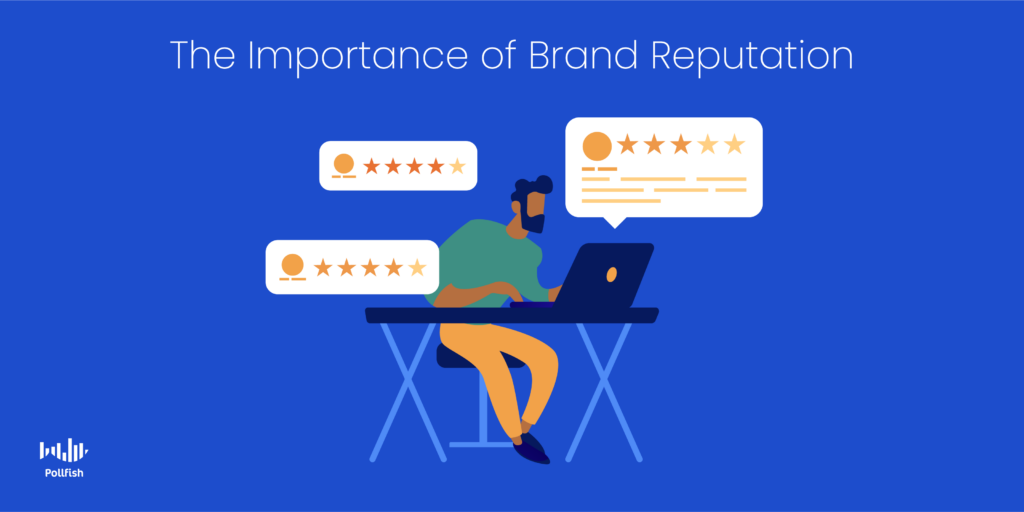
Your business’s financial value will rise, as it correlates with higher demand and sales, both of which are the benefits of a strong reputation.
Furthermore, it is key to build a healthy brand reputation, as positive brand impressions will lure in more potential customers. This is the by-product of reaping a higher demand for your products and business. As such, a good reputation helps you acquire more customers.
Aside from acquiring new customers, your brand reputation can also help you increase your consumer loyalty. This ties into the idea of customer trust. When customers trust you, not only will they patronize your business once; instead, they’ll be inclined to make repeat purchases.
These are the core of customer retention, the concept that maintains lasting business relationships. When your customers stay with your business for a long time, they grant you a high customer lifetime value, which is the total monetary value a customer brings to a business across their lifetime. This is one of the main benefits of customer retention, which you can establish by maintaining and improving your brand reputation.
It is key to maintain a good reputation, as it also affects the employees of your business. Businesses with poor reputations will suffer higher turnover rates. When businesses have a terrible reputation, they are far less adept at recovering from losing their talent. This is because a bad reputation costs a company at least 10% more per hire.
All in all, it is in the best interest of all businesses to build, track and maintain a healthy brand reputation.
How to Use Surveys to Measure and Improve Brand Reputation
Building a strong brand reputation is highly bent on satisfying your customers. In order to satisfy them, you’ll need to conduct certain market research techniques, as market research is primarily focused on studying your customers.
Surveys, in particular, give you quick and easy access into the minds of your customers, allowing you to understand their consumer preferences, needs, desires, aversions and virtually all else.
As such, you can use surveys to obtain customer feedback on the way your customers perceive your brand. In doing so, you can evaluate your brand reputation directly from the customers themselves.
But even more important is that by using survey research, you will gain the intelligence necessary to correct any issues that trouble your customers, along with optimizing your products, services and customer experience.
By removing bugs and improving your entire customer experience, you’ll delight your customers and maintain a solid brand reputation, the kind that will allow you to reap all of the benefits of it. You’ll just need to track it.
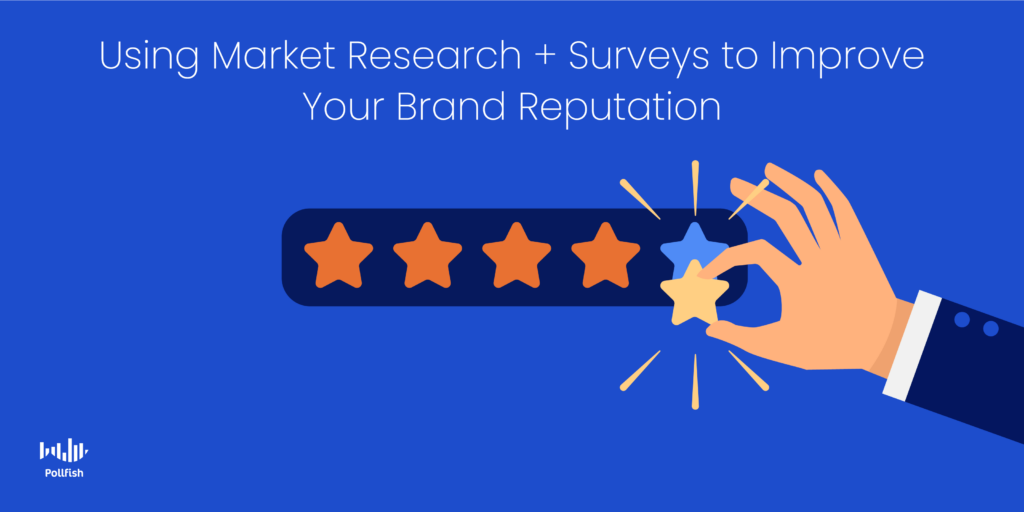
The following explains how to measure and improve your brand reputation through market research, including survey usage:
- Do an internet search of your business.
- Read review sites, forums, social mentions and all other places that mention your brand.
- Check for long-form content if you operate a major brand, such as blog posts, articles and new pieces.
- Conduct secondary market research on your customers.
- Pay attention to what your target market responds well to, along with what they dislike and object to.
- It’s key to study scandals within your industry so that you can avoid them.
- Example: lawsuits, tales of unhappy customers.
- Conduct secondary market research on your competitors.
- Make sure to study how your competitors have handled scandals.
- Pay heed to companies that fell from grace and how they bounced back, along with those that didn’t improve their reputation.
- Learning from your direct and indirect competitors will help you avoid running afoul your customers, industry and media.
- Speak to your customers.
- Conduct one-on-one interviews, phone interviews or focus groups to learn more about your customers’ pet peeves, triggers, etc.
- In addition, ask them about how they feel about your brand and ask for comparisons with other brands.
- Conduct a survey to assess your own reputation.
- Based on your prior research, conduct a survey asking customers to reveal their perceptions about your company.
- Alternatively, you can begin your research by using a survey alone.
- Use a brand perception survey to do so.
- Make sure to ask customers about familiarity with your brand first if you’re deploying your survey to a massive network.
- Survey existing customers. In this case, you don’t need to ask about their familiarity with your brand.
- Analyze your market research.
- This includes your earlier secondary findings, your direct talks with customers and your survey data.
- Run more surveys if you need more information.
- You ought to create follow-up questions and send them to specific people.
- Alternatively. You can call customers to discuss their survey results if this is their preferred method of communicating their perceptions.
- Take action.
- Take action after you consolidate all of your dings, including those of follow-up/additional surveys.
- If you find your reputation to be in good standing, don’t make any changes.
- Rather continue doing as you were before.
- You should also consider creating similar marketing campaigns if your customers put in a good word about them.
- Don’t stop. Continuously track the standing of your brand.
- Use the brand tracking survey to assure good brand health.
- Additionally, run surveys that track brand visibility, so that your brand has not fallen by the wayside, that is, become forgotten about.
Creating a Reputable Brand
Building a reputable brand is a must for your business to survive and remain competitive.
Sustaining a strong reputation goes beyond avoiding scandals and bad press. You’ll need to constantly satisfy your customers and stay relevant in order to sustain a healthy brand reputation.
Conducting market research with surveys helps you achieve these goals. You’ll need a strong online survey platform in order to carry out all of your research.
Use an online survey platform that makes it easy to create and deploy surveys to your target market. You should also use a mobile-first platform since mobile dominates the digital space and no one wants to take surveys in a poorly constructed mobile environment.
Your online survey platform should also offer artificial intelligence and machine learning to disqualify low-quality data and offer a broad range of survey and question types.
Additionally, it should also allow you to survey anyone. As such, you’ll need a platform with a reach to millions of consumers, along with one that offers the Distribution Link feature. This feature will allow you to send your survey to specific consumers, instead of deploying them across a vast network.
With an online survey platform that offers all of these capabilities, you’ll be able to continuously measure and improve your brand reputation, allowing your business to satisfy your customers and remain competitive.
How to Develop a PR Market Research Study
How to Develop a PR Market Research Study

A PR market research study couples two business concepts that appear unlikely to be linked together. After all, PR and market research have maintained a steady distance from their business cousins, known as advertising and digital.
As such, PR and market research are not known to be typically used in tandem, if used together at all.
However, given all the changes in market research over the past several years, from the possibility of agile research, to the emergence of mobile market research and the advancement of data democratization, the realm of PR has much to gain from conducting a market research study.
Much of these changes in the market research sector have already been detected by PR professionals, 58% of which believe that technology will drive considerable change to the PR industry.
In addition, the global PR market is forecasted to grow by 10.2% by the end of 2021, chiefly due to businesses recovering from the COVID-19 pandemic and using technology to reorganize their business.
With technology and innovation acting as the chief drivers behind market research progress, the PR industry can feasibly take advantage through the use of a PR market research study.
This article explores the PR market research study, its use, benefits and how to develop and promote one for your business or PR agency.
Understanding the Meaning of a PR Market Research Study
Market research has extended into all subsets of marketing and business practices. You’re probably familiar with or at last heard of how to do market research for a business plan. A PR market research study essentially takes this concept and implements it for PR purposes.
As its name suggests, this is a kind of market research study designed to extract primary data to support public relations campaigns. This involves empowering a range of PR intelligence and campaign requirements.
How a PR Market Research Study Works
This kind of study is conducted to use the research results that you garner for broadcasting, whether it is for press releases, company outreach, branded content, blogs, news sites and other media outlets, including print.
You can conduct a PR market research study through various market research techniques, including secondary research sources such as industry blogs, news sites, statistics sites and more.
No market research campaign is complete without conducting primary research, as this form is the most unique to a brand, along with being the most relevant, precise and up-to-date kind of research.
This is because, given that primary research is self-conducted, the business or PR agency wields complete control of the study. As such, the party conducting the study decides the topic at hand, the direction of the market research campaign, the types of survey questions, the specifications of the target market sample and virtually all else.
You can conduct a PR market research study through PR surveys. A DIY survey leads the way in innovation when it comes to performing market research for PR purposes. This is because it accelerates the survey completion process, allowing anyone to conduct a survey rather than relying on a firm via the syndicated research method.
When you run a DIY survey campaign on a strong online survey platform, you won’t sacrifice speed for quality, as a strong platform offers various quality checks to stamp out low-quality data and survey fraud.
The Importance of a PR Market Research Study
This study helps gain critical insights for a wide array of public relations needs. As such, it carries importance for various PR efforts, fulfilling the needs of companies’ in-house PR teams, along with those of PR firms.
When it comes to pitching branded content, a press release or any other PR content to media outlets, a PR market research study allows you to gain all the insights you need on any demographic. This way, your brand can forge compelling storytelling and much-needed content for your company, the kind that captures the attention of journalists, bloggers and other media mavens within your niche.
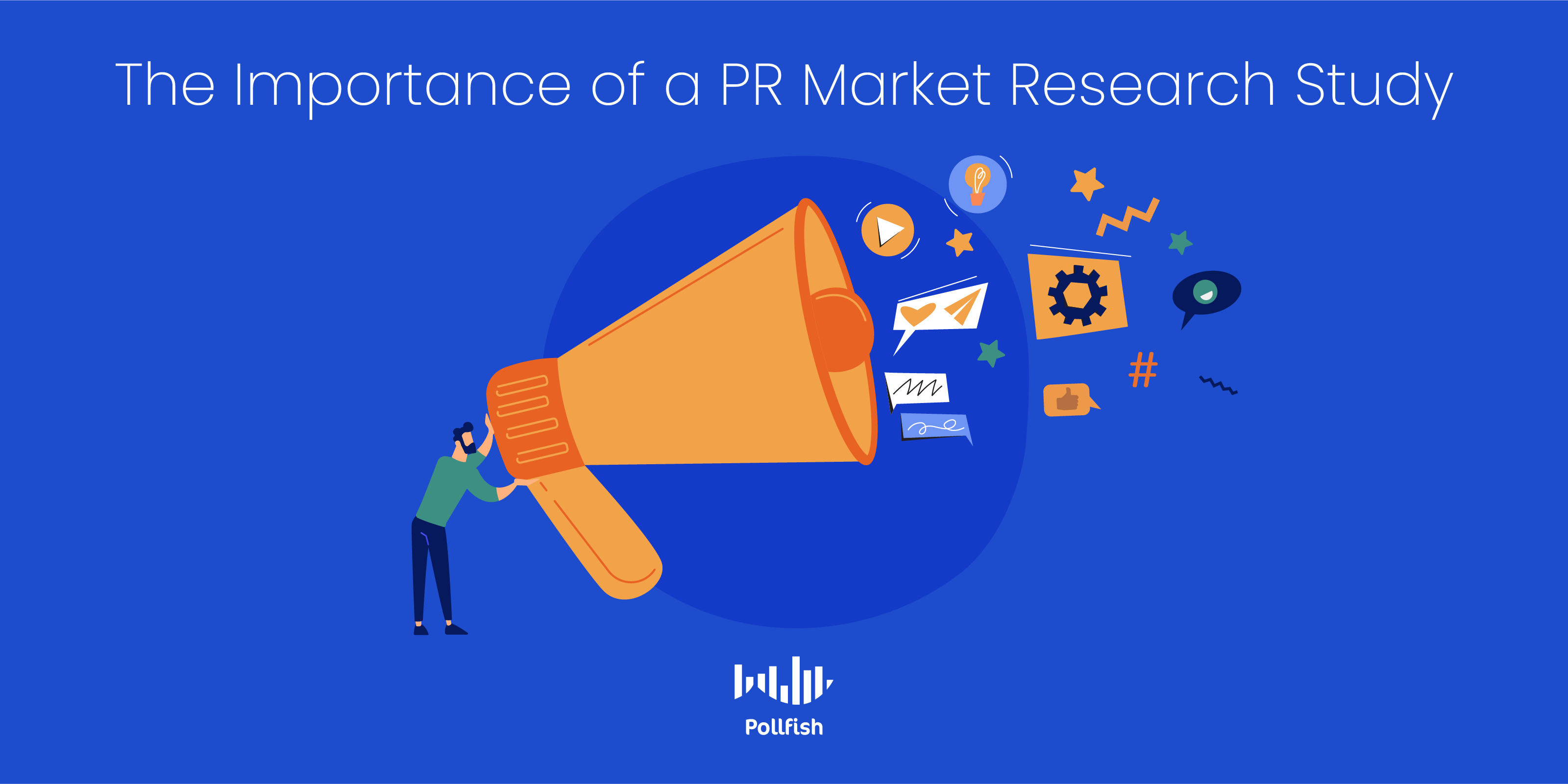
This allows you to maximize the effectiveness of your pitch and press efforts, given that this kind of study aids you with credible data to reel in the attention of your desired publication, support your claims, make headlines and build brand trust.
There are also various efforts a PR market research study can assist with when it comes to planning a new project. This involves gaining insights on how competitors are faring in their PR efforts and their brand equity, how to perform on different channels including traditional and social media and how to tinker with your messaging to frame your brand in the best possible light.
A PR market research study allows you to measure existing attitudes from your target market in regards to your brand. This also helps put your brand awareness and brand visibility into perspective.
When examining the attitudes, opinions and perceptions of your target market or even the public, you can track how these aspects have changed before, during and after a campaign to understand its effects. This will help you decide whether to continue with a campaign, change its course or end it completely.
You can A/B test the communications you intend on releasing, whether it is for forming the basis of a PR story, the images you seek to test or the opinions on the statistics you’ve gathered from an earlier market research study.
These PR elements, along with any others you seek to test or survey your respondents on, are vital to the success of your PR campaign. Thus, a PR market research study benefits your business in regards to all of your PR efforts, as the data you extract can inform your ongoing PR efforts and support new ones.
How to Develop and Promote a PR Market Research Study
Performing a PR market research study is not as difficult as it may appear to be. By following instructions in a step-by-step fashion and using a strong online survey platform, the kind that allows you to make your own survey in three simple steps, you can establish an insight-driven PR market research study.
The results of a well-planned PR survey will enable you to produce the media placements you seek, as many news outlets are keen on publishing B2C and B2B survey results. The media is especially bent on publishing controversial survey results, as these kinds gain more reach and therefore media coverage.
However, there are some survey reports that generate little to no publicity. As such, the reporters and editors you pitch to will discard your media pitches. This is because not all survey studies manage to obtain media attention, especially from the companies that don’t frame their results properly.
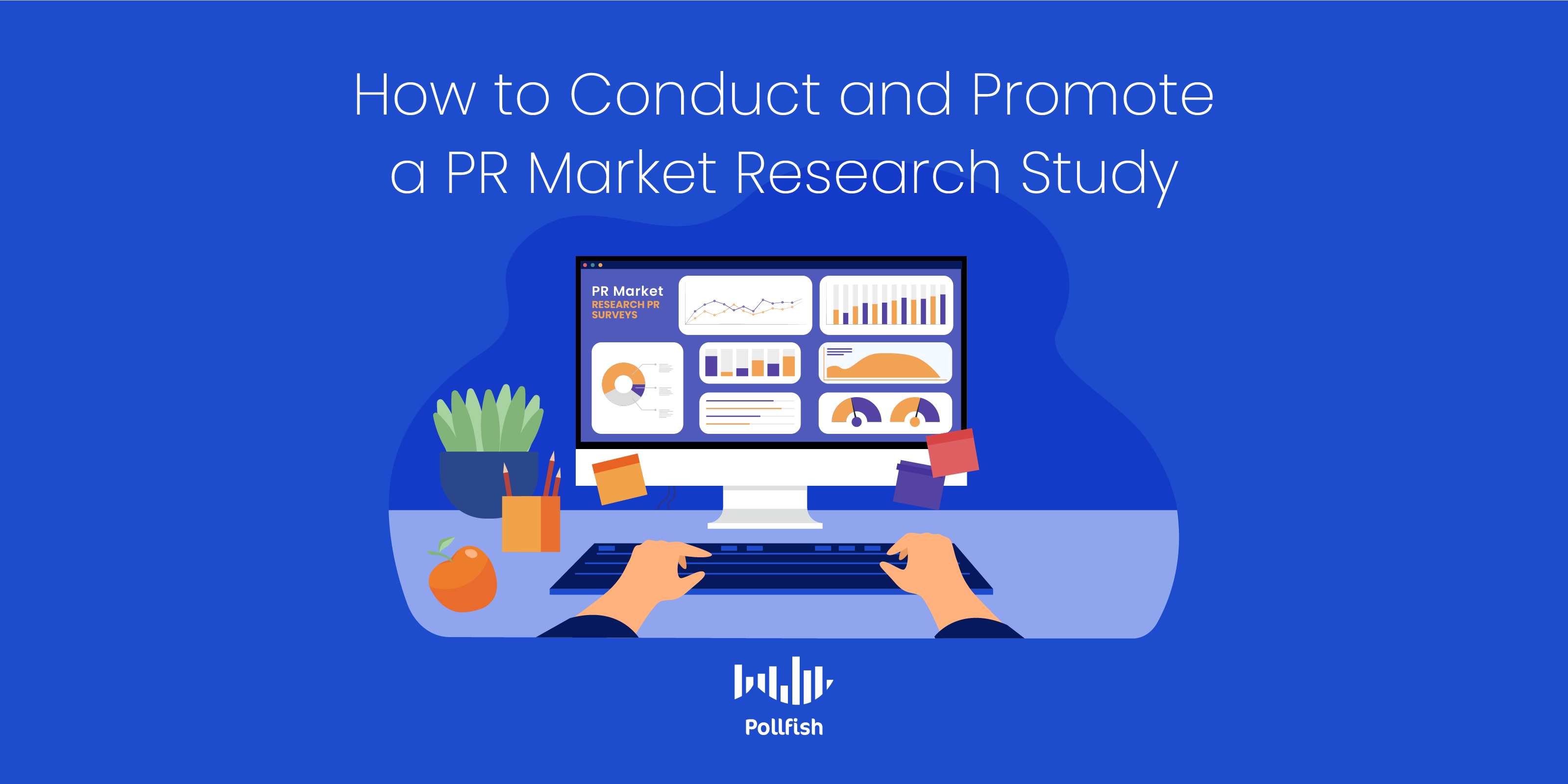
A PR market research study helps you prevent rejections, by testing your post-survey findings via the aforementioned A/B testing and other surveys. The following provides the steps you ought to take to develop and promote a PR market research study
- Find a topic or issue that you would like to study.
- This will serve as the basis of your market research study. Make sure that your topic is culturally and thematically relevant to your industry.
- Come up with a few key questions you need answers to, especially as they relate to the topic of your study. These preliminary questions should involve your niche.
- Maintain a study topic and questions as original as possible.
- You should attempt to frame them to extract compelling results, the kind that sparks media attention.
- For example, you can frame your findings as follows: “25% of readers are unhappy with the fashion industry and seek more relatable models.” This headline points out a problem, one that your business can potentially fix, which you can include later in your content.
- Choose a potent online survey platform and a survey research method.
- You ought to opt for a DIY survey, as aforementioned. This will grant you speed to insights and grant you full control over the PR market research study.
- Online surveys tend to be a cost-efficient method for running your business survey.
- Make sure you use the correct survey sampling size.
- This will ensure accuracy within your studied population and statistical significance.
- The platform you use should assist you with this with a sample size calculator.
- Promote your PR survey study.
- You can do so via direct mail, PR, social media and online advertising to promote the survey for its intended respondents. In order to do this, your survey platform will need to offer the Distribution Link feature, which allows researchers to send individual surveys to specific people, rather than being mass-deployed.
- You can also advertise the survey on websites, especially those that you would want to publish the survey results.
- Consider using survey incentives.
- These can be either monetary or monetary.
- Depending on the online survey platform you use, some incentives may exist within a mobile game or app. As such, the prizes you can award to respondents who complete your survey would exist in their game or app, such as points, lives, extra time, etc.
- Analyze your survey results.
- You can do so by filtering data options available on your survey platform.
- Do not exaggerate or misuse the findings. Otherwise, your brand will lose credibility and will mar its reputation, since your data will be illegitimate.
- Survey publicity won’t work when it misleads or downright lies about results.
- Try to look for interesting results that your industry may not have expected.
- Mull over relevant and news-worthy pitch angles and headlines.
- Write an outline of your story with your headlines in mind.
- Write a pitch based on your story content. Consider two or more versions of it.
- Run another survey to see which version your respondents find the most interesting and compelling.
- Make sure your survey doesn't have duplicative information.
- Conduct secondary research to assure your competitors haven’t released similar findings and stories. These won’t generate demand from media outlets or readership.
- If your survey resembles a competitor’s, conduct another one that is either more in-depth, or covers another topic.
- Contact the media.
- Have a list of media contacts you’d ideally like to get in touch with to publish your findings and/or their PR assets.
- Provide a high-level description of your study survey so that they open your email pitch.
- Ask if they are interested in surveys and if they prefer to see the raw results or your writeup of them.
- Highlight the main points in your pitch.
- Summarize a few key findings that deal with a specific business issue is a favorable approach for increasing your chances of landing media coverage.
- Don’t put off reporters by sending raw data.
- However, some outlets may require submitting the complete survey data for review.
- Keep product promotion to a minimum if you must mention it at all.
- Pitches that are overly self-promotional are unlikely to convince journalists to use your pitch.
- Lead your story with an unexpected statistic, even if it doesn’t fully bolster the sponsor’s key message.
- Include promotional content further down in the news release.
- Take part in as many other promotional activities as possible.
- Doing so will generate attention, brand awareness, interest and leads.
- Write an op-ed; this kind of asset has the prowess of swaying opinions. In addition, there are online media channels that distribute op-eds.
- Blog about the findings/ PR asset on your website.
- Create social media posts touting your findings.
- Reach out to social media influencers to post about your results. You should ask them to link to your blog, op-ed or other PR content asset.
Meeting All PR Expectations
You can meet all of your PR expectations by conducting a PR market research study. Such a study will grant you unique insights you can use to churn out PR content and learn which kind of stories and assets resonate with respondents the most.
In order to adequately run this kind of study, you’ll need to use the proper online survey platform. While there are many such survey platforms, choose the one that offers the most capabilities.
For example, you ought to use the kind that operates on random device engagement (RDE) sampling, allowing you to reach respondents in their natural digital environments, which reduces various kinds of survey bias.
You should also opt for an online survey platform that implements artificial intelligence and machine learning to disqualify survey fraud and poor-quality data and provides a mobile-first approach design.
An online survey tool with these functionalities will allow you to carry out all PR market research studies and other market research campaigns, at speed and at scale.
The Complete Guide on Market Research vs Market Analysis
The Complete Guide on Market Research vs Market Analysis
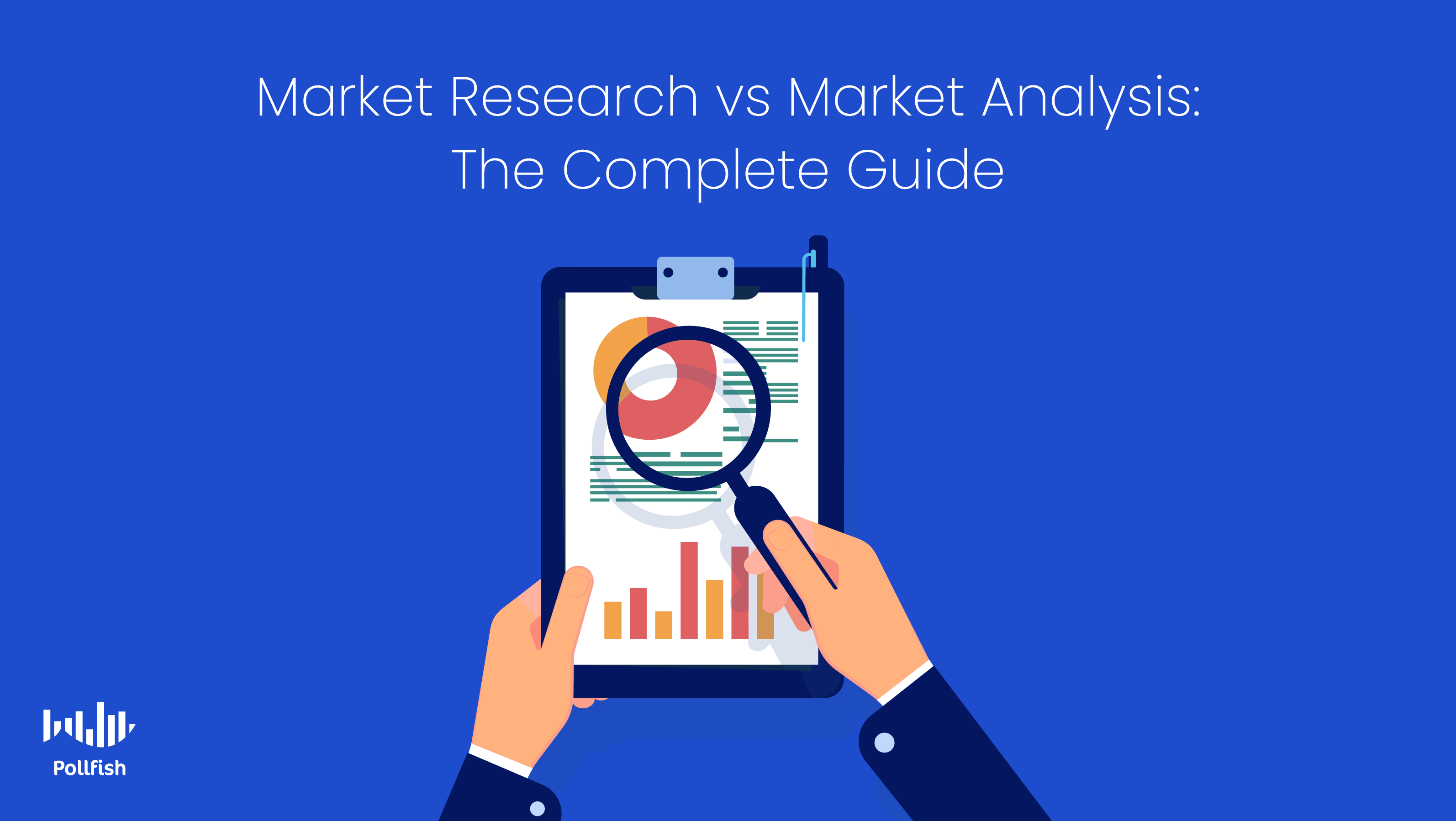
Market research versus market analysis. This is a topic of contention for many in the business and research worlds. Both of these concepts yield critical data and intelligence for businesses and both of them are necessary to sustain a business.
Both market research and market analysis empower businesses to analyze areas of their industry, predict future trends, hone their business practices and lead organizations effectively. They both deal with big data problems from time to time. Both of these concepts also allow businesses to assess industry expectations and meet them.
However, although these terms are used interchangeably and offer similar business benefits, they are not the same thing, as each represents different key factors, processes, objectives and methodologies.
We’ve taught you about the differences in market research vs. user research. This guide lays out market research vs. market analysis, allowing you to understand all of their key facets and differences, so that you can understand when and how to apply both.
Understanding Market Research
Market research refers to a process that is far more specialized than market analysis, as it entails examining a specific market and its corresponding customers. It is usually bent on answering distinct questions regarding customer behavior along with all else that pertains to a target market, which is the group of consumers most likely to buy from a business.
Market research involves studying customers at an in-depth level, which therefore includes segmenting them into distinct groups and designating them with individual customer personas. This involves the practice of performing market segmentation, along with conducting secondary and primary market research techniques prior, during and after administering market segmentation.
Aside from referring to and implementing primary and secondary resources, market research encompasses both quantitative market research and qualitative market research methods.
Given that this kind of research is centered around customers, it examines a variety of customer traits and characteristics. They include the following:
- Customer buying behavior
- Customer preferences
- Desires and needs
- Customer aversions
- Opinions and sentiments in regards to
- Values
- Products
- Cultural trends
- Current events
- The industry at large
- Prices
- Lifestyles
- Behaviors
- Customer experience (CX)
- Views on the industry at large
- General feedback
Market research is a practice undertaken by business owners, researchers, analysts, marketing departments and even individuals. Essentially, market research is used to gather feedback and data directly from the customers, mainly to assess the viability of particular business decisions.
The Importance of Market Research
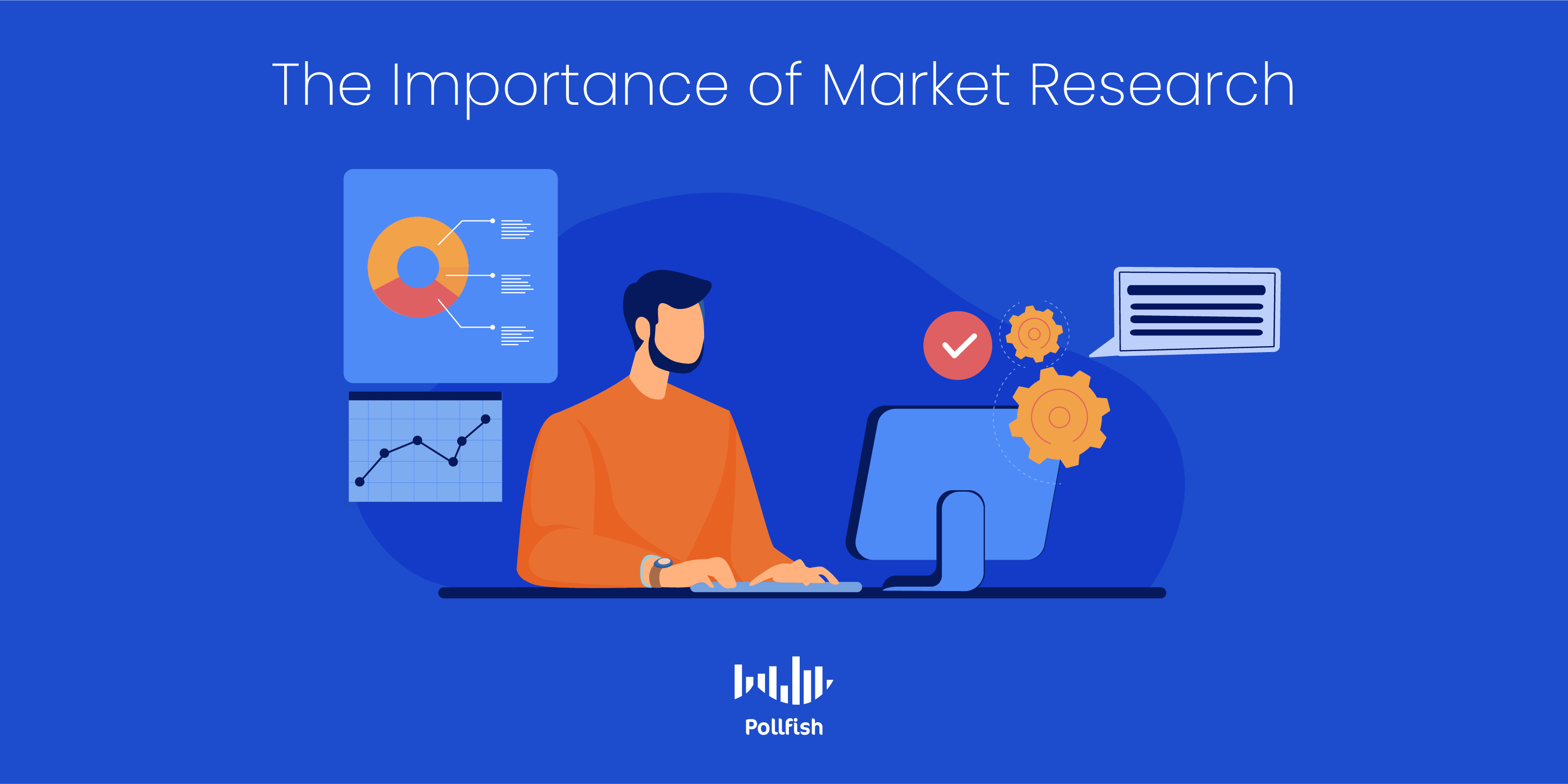
Market research carries a great deal of importance, as it empowers all businesses with critical data that steers them towards making the right business decisions.
Firstly, it’s important for startups and new businesses to conduct market research before launching their business or even innovating on a product. Although it is tempting to push a product to market, a lack of market research has grave consequences.
It is difficult to acquire new customers for established businesses, as it costs five times more to acquire a customer than it does to retain an existing one. Additionally, selling to a new customer has a low success rate of 5-20%, while selling to an existing customer has a success rate of 60-70%.
This environment exists for existing businesses. It is even more arduous for startups and yet-to-be registered businesses to gain a customer base. As such, these businesses must conduct market research. It grants them valuable knowledge about the particulars in their industry and most importantly, their target market.
Only when you understand your customers can you serve them properly. After all, you're not just selling a product or service. Businesses of the present can only survive if they provide a strong experience for their customers. 73% of U.S. customers say that CX is a very important factor in their purchasing decision. 1 in 3 custumers will leave a company after just one bad experience.
Clearly, customer experience is vastly important and in order to create positive experiences that not only draw in but retain customers, you’ll need to understand your customers at a deep level.
Market research makes this possible, as it allows you to learn everything about your target market, segment them into smaller, more distinct groups that you can dedicate to different campaigns and satisfy them continuously.
Understanding Market Analysis
Market analysis is the process of examining a particular market, industry, niche or segment. It is carried out by way of quantitative and qualitative assessments of a market.
This analysis relies on raw data that predominantly focuses on a market's size and potential. As such, it involves studying a market by observing various factors that involve these two concepts.
A market analysis involves observing the following aspects: market volume, value, its different customer segments and their customer buying behavior, economic conditions, regulations, the competition, barriers to entry and political, social and cultural trends, as they relate to the market.
A market analysis uses current and historical data to forecast future market events and outcomes. This data includes information on the above topics of observation. Businesses use market analyses so that they can understand how their products and experiences may exist under a certain environment.
This kind of analysis allows companies to plan ahead for the future in a strategic way, using data for decision-making. This is because it allows companies to get a plain understanding of the most important factors of their market.
A market analysis is an all-encompassing practice of examining a market, therefore, it uses a wide range of sources. This involves using market research to provide key information on customers and other aspects of the market. By relying on a vast number of sources, a market analysis can assess and predict all of a business’s growth options, as well as its possible stumbling blocks and limitations.
In short, a market analysis gives businesses a broader understanding of their market by relying on multiple means and sources of data that pertain to various aspects of the industry.
The Importance of Market Analysis
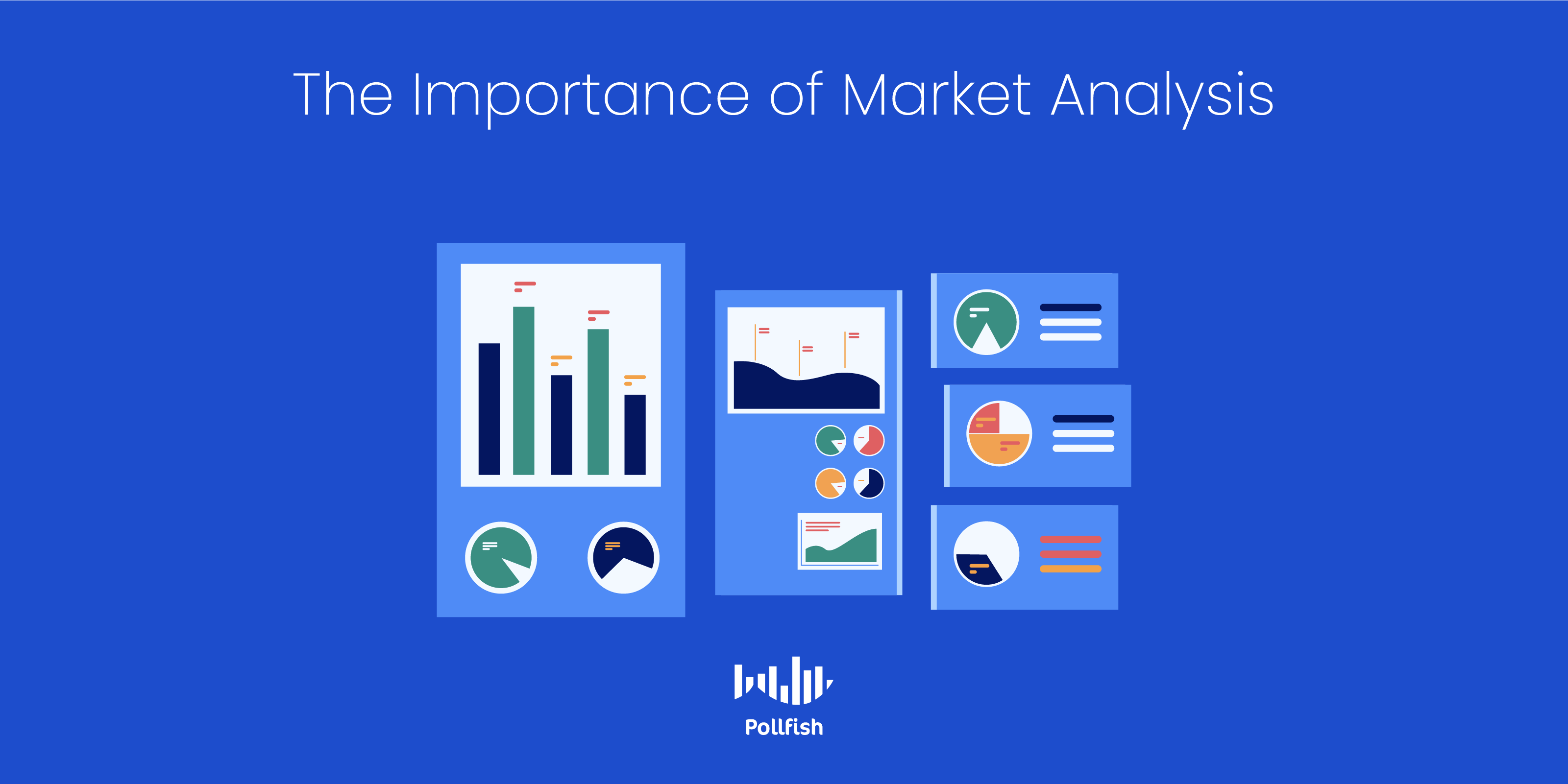 Market analysis is important for a variety of reasons. Almost every successful product or service of the present involves having conducted a thorough market analysis. This analysis is often the first and the most significant stage in the development of a marketing and business plan.
Market analysis is important for a variety of reasons. Almost every successful product or service of the present involves having conducted a thorough market analysis. This analysis is often the first and the most significant stage in the development of a marketing and business plan.
The process of a market analysis is important, as it allows business owners to evaluate whether their product or service will satisfy their customers’ needs. This way, they don't waste time on producing products, product updates and features that will perform poorly and generate few sales.
A market analysis helps gain insights into the shifts occurring in the economy. This can include changes in regulations that directly or indirectly affect your business. It also helps you stay aware of market trends, which puts supply and demand in perspective.
This helps you set reasonable prices that are commensurate with demand. It allows you to understand the desirable products and services along with those that drive little demand. These key aspects enable your business to become fully acquainted with the economy, along with the particular one of their industry.
In addition, this kind of analysis is important in that it provides insights into your target market, the segment of the market most likely to be your customers. It does so, as it involves studying your demographics along with their behaviors, traits and expenditures. In this sense, market analysis is critical as it implements market research.
Furthermore, a market analysis will help you plan the most promising strategy to market your product or service product. This is because when analyzing the key facts of your market, many marketing messages will come your way.
Even by casually browsing your competitors’ sites and social channels, you’ll discover various marketing techniques, from ads, to landing pages, webinars, promotions and much more. This will give you critical information on the kinds of marketing methods to test and try.
Given that a market analysis touches on so many components of a market, it equips businesses with essential knowledge for making auspicious business decisions. This kind of knowledge allows you to complete a business plan, as it has its own section, showing prospective and plausible investors that you understand your market.
The results that your market analysis draws enables your company to identify both the opportunities and risks of your particular market. All in all, this kind of analysis sheds light on all the foundational aspects of a business, along with its main ongoing concerns. This kind of knowledge will inform and bolster all kinds of business endeavors.
The Key Differences Between Market Research and Market Analysis
There is considerable overlap between market research and market analysis, given that some market research projects may include a market analysis and especially since market analysis encompasses market research.
Additionally, you can complete both a market analysis and market research for a business plan. You can use both of these insights-rich methods to support a wide array of different documents and reports. Both of these can point you to the appropriate action based on the data you collect.
However, these two terms are not the same and should, therefore, not be confused with one another.
The main differentiating factor between them is that market research is inclined on gathering customer-specific intelligence. Market analysis, on the other hand, seeks a far more expansive perspective of a market, thereby relying on more resources, to execute all the possible business forecasts and examine all growth options.
Whereas market analysis is broad, market research is much more specific and fine-tuned. Market research is therefore restricted by the population of studies, emotions and time, as well as different kinds of human interaction.
In contrast with market research, market analysis works by depositing large quantities of data into a large storage framework. Market research works by collecting specific data points necessary for answering certain research concerns.
Market analysis often yields results that last in the long-term, while the results of market research tend to be valid for several months to years, depending on the population and theme of the study, given that public opinion can change quickly.
In conclusion, market analysis strives to render a clear picture of the majority of a market, while market research is focused on understanding its customer base and those possible prospects.
Reinforcing All Your Research and Analysis Needs
Market analysis and market research are two exceedingly important processes of gaining information to bolster your business. Despite their similar nature and often conflation, they are two distinct practices and should not be mistaken for one another.
However, in order to conduct market research and even garner intelligence for market analysis, your business ought to use a strong online survey platform. It can be used to study your customers on a deep level, along with what people perceive in your market. You can also send surveys to specific people with Link Distribution, allowing you to better understand your market by surveying key players.
To do so, you ought to look into a strong online survey platform, the kind that operates via random device engagement (RDE) sampling, which reaches respondents in their natural digital environments, scaling back on survey bias.
You should also opt for an online survey platform that implements artificial intelligence and machine learning to disqualify survey fraud and poor-quality data and offer a mobile-first design.
Such a platform will ensure you gain the most quality insights on your market and customers in a timely way.
How to Perform a SWOT Analysis on Your Company with a Market Research Tool
How to Perform a SWOT Analysis on Your Company with a Market Research Tool
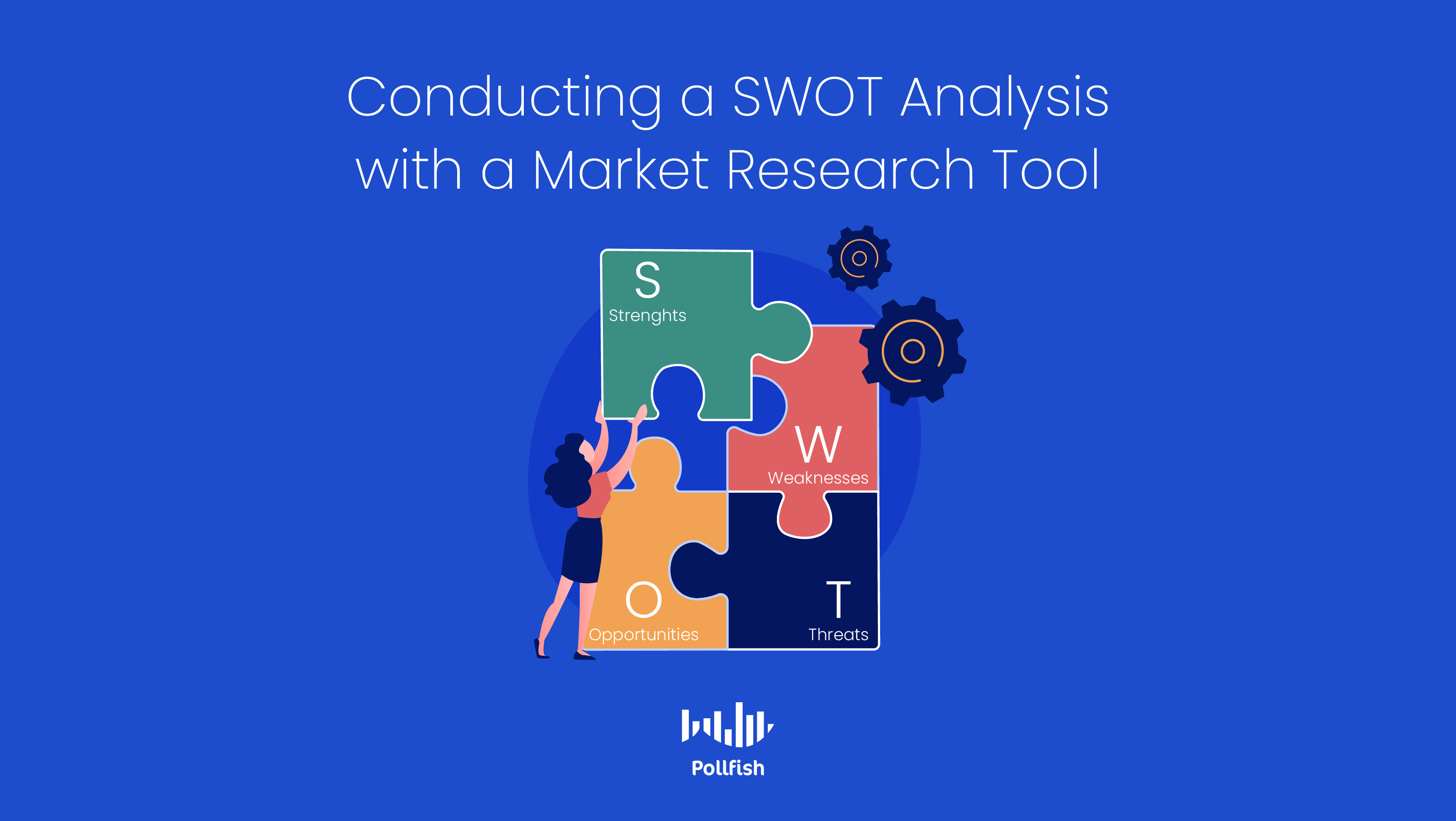
A SWOT analysis is a simple framework that goes a long way towards helping businesses develop their strategic planning process along with grasping their own stance in their industry. In turn, this kind of analysis allows them to make informed business decisions.
This is because all businesses have their share of strengths and weaknesses, and no company exists in a vacuum. As such, you should analyze the opportunities and threats that pervade your market to take advantage of your scope of opportunities while steering clear of threats.
A SWOT analysis allows you to do just that, in turn enabling you to understand your company’s position in your market or niche and use this knowledge to take scalable actions.
This guide explores the SWOT analysis, its importance, how to conduct one for your business and how to use a market research tool to complete your analysis.
Understanding the SWOT Analysis
Also called the SWOT matrix, this analysis is a kind of strategic planning technique businesses use to identify internal strengths and weaknesses and external opportunities and threats. Its components are laid out in its name, which is an acronym for strengths, weaknesses, opportunities and threats.
A SWOT analysis is a visual study tool that identifies specific strengths, weaknesses, opportunities and threats and presents them in a diagram that takes the form of a two-by-two grid.
This grid features four quadrants; each one represents one of the letters of the SWOT and its concept. Each quadrant houses the list regarding the concept behind the letter. This format organizes the elements as internal versus external.
You can conduct a SWOT analysis on an entire organization, or on individual projects in a single department. Aside from evaluating a company or project, a SWOT analysis is used to determine how closely a business is aligned with its growth trajectories and benchmarks. Additionally, it is used to gauge the performance of a specific project, such as a PR campaign based on preliminary predictions.
A SWOT analysis is most ideal when diverse groups or voices within a business provide actual data points rather than suggested messaging.
The Makeup of a SWOT Analysis
The SWOT analysis is made up of a grid with four quadrants, which represent each letter of the SWOT. To understand which quadrant an idea belongs to, you ought to consider strengths and weaknesses as internal factors, as they deal with the organization, its people, workflows, processes and assets.
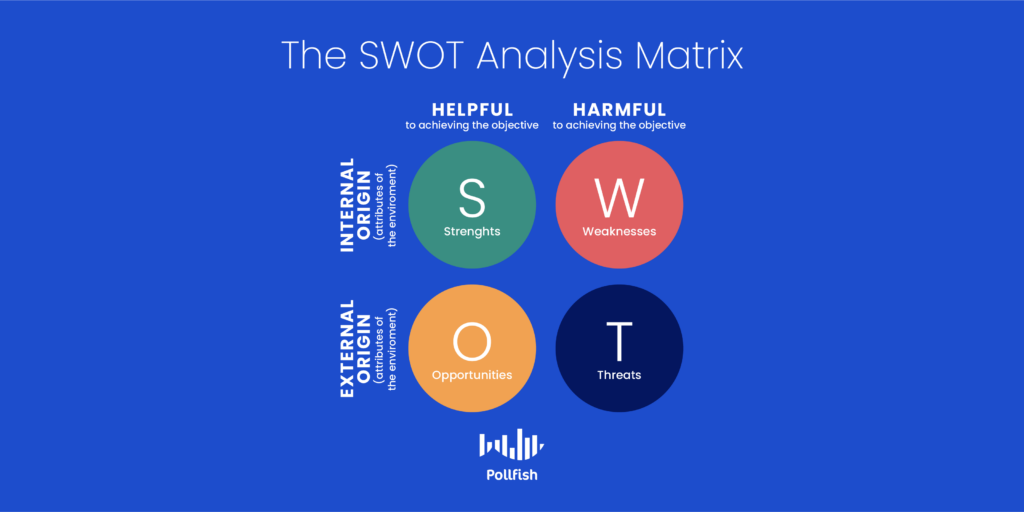
On the other hand, opportunities and threats are external factors, given that they originate from your niche, your competition, your market and the wider economy. The following explains each element of this framework in detail:
Strengths
This element pertains to all the things your organization excels at and how you are distinct from your competitors. It, therefore, involves your advantages over other businesses, which include your price range, quality of service/products, customer experience, access to certain materials, employee satisfaction, manufacturing processes and more.
Since your strengths empower your organization, consider the factors that make it operational. Answer the following questions for the Strengths portion of your analysis:
- What does your business do better than others in your industry?
- Which business processes are successful?
- What assets do your teams have? (brand equity, knowledge, education, network, skills)
- What values drive your business?
- What kind of physical assets do you have, such as equipment, technology, cash and patents?
- What unique or valuable aspect does your business have?
- What kind of low-cost resources can you draw upon that your competitors can't?
- How are you innovating your products and business processes?
Virtually any aspect of your business can be considered a strength if it brings a clear advantage to your business. If all of your competitors provide a certain aspect, then it becomes a necessity, not an advantage.
Weaknesses
While admitting the weaknesses in your organization may be unpleasant, these truths are critical to aggregate and examine as soon as possible, as you can only mitigate them when you accept them.
Given that weaknesses are innate to your company, you should map them out by focusing on your offerings, systems, people, resources, and procedures. In the weaknesses quadrant, mull over all that you can stand to improve and the kinds of practices your company must avoid.
To do so, you’ll need to consider — and possibly uncover — how others in your market view your business. These actors, which include your target market, competitors and media outlets in your niche may notice weaknesses that you are not aware of. As such, to complete this section, investigate how and why your competitors are doing better than you to come to terms with what you lack.
Use the following questions for the Weaknesses portion of your analysis:
- What are some of the things that your business needs to be competitive?
- Which areas of your business generate the least ROI?
- Are there any aspects of your business that require more resources? (Such as a department, a project, etc.)
- Which business processes need improvement?
- Are you lacking tangible assets such as money, space or equipment?
- Are there any gaps in your team?
- Is your location ideal for your success?
- What areas are your competitors excelling at which you aren’t or not as strong as they are?
All in all, weaknesses are the negative factors that detract your business from its strengths. You ought to consider how to reduce them, along with your key areas for improvement to remain competitive.
Opportunities
This section involves all the openings and probabilities of something positive happening to your business, whether it is publicity, higher profits, greater ROI, a larger social media following and various other business matters. You must claim opportunities for yourself, as the nature of an opportunity is that of an external situation which you must look out for so that you can use it to your full advantage.
Opportunities take the form of developments in your market, whether they are technological, service or experience-related. When it comes to being competitive in your market, spotting and using opportunities makes a major difference to your business. At times these opportunities allow you to position yourself as the leader in your industry.
At other times, opportunities can take the form of small advantages that can still effectively shape your competitiveness. These can be present in both market trends and cultural trends.
You should also anticipate changes in government policy related to your field. These can involve regulations that create barriers for your business. Additionally, take heed of changes in social patterns, population profiles and lifestyles, as all of these can offer opportunities.
Use the following questions for the Opportunities portion of your analysis:
- What interesting market trends are you aware of, large or small, which could impact your business in a positive way?
- If your market is growing, are there trends that will encourage people to buy more of your products and/ or services?
- What events can your company take advantage of to grow the business?
- Are there any imminent changes to regulations that might affect your company positively?
- Why kind of content opportunities can you execute to your advantage?
- Are there any current events or cultural trends that you can capitalize on?
- Are your vendors or manufacturers offering any perks or bargains that your business can benefit from?
- Do you receive cold emails with opportunities to either be featured in or collaborate with a media outlet or company in your niche?
Threats
This element includes anything that can negatively affect your business from the outside, including, but not limited to higher standards in market requirements, supply chain issues, shortage of employees, negative press and more.
No matter your revenue or standing, you should always anticipate threats to your business and be prepared to take the necessary action to thwart them before they take a toll on your business and stunt your growth.
Threats can arise from anywhere; as such, consider all the obstacles you contend with in getting your product to market and selling it. These can easily include constant changes to quality standards or specifications for either your products, services or overall CX (customer experience). You’ll need to adapt to these changes if you intend on being competitive.
Additionally, although changes in technology are generally viewed positively, they can present threats to your business. As such, you should be wary of these changes so that you can adapt to them before they become true threats.
Use the following questions for the Threats portion of your analysis:
- Do you have any potential competitors who may enter your market?
- Could upcoming developments in technology change how you do business?
- Have any media outlets spoke negatively about your business or focused their attention on praising your competitors?
- Will your vendors always be able to supply the exact materials you need at the prices that you seek?
- Is customer behavior changing in a way that could have a negative impact on your business?
- Are there any issues with your employees that can lead to high turnover and negative reviews?
- Are there any regulations the may have negative consequences on your business?
- Are there any market trends that could potentially become a threat?
Although threats are external and you have no control over their presence, you can still keep them at bay by conducting various market research techniques.
The Importance of a SWOT Analysis
This kind of technique is important on several fronts. First off, in a general sense, it allows you to make well-informed decisions, as it makes it possible to prioritize the work that you’ll need to do to grow your business.
Understanding your company's position in your market or industry is crucial for any business in that it allows you to strategically develop your business and avoid wasting resources, efforts and time. This is crucial for various situations and scenarios, whether you’re trying to expand into a new market or compete with a surprise contender in your industry.
A SWOT analysis provides a comprehensive and unbiased overview of your entire business or a specific campaign or product. It forces you to consider every factor that could affect your project or business in one way or another. This is especially useful if you’re dealing with difficulties or lack confidence in your current strategy.
This is because a SWOT analysis offers all the details you’ll need to make actionable plans. The four quadrants grant you an easy way to organize your insights.
This analysis helps your business operate more strategically, thereby granting you a better chance of reaping success. This is because it addresses what your business lacks, which allows you to minimize risks. It also pinpoints your greatest advantages and chances of success.
A SWOT analysis can be used to jumpstart your strategy whether it is in an informal or full-fledged way, as this tool can serve both approaches.
Finally, you can also use it to better understand your competitors and their standing. This kind of intelligence lessens their threat to your business, as you can form a competitive narrative for your business, based on your analysis of your competitors.
Performing a SWOT Analysis & The Need for Conducting Primary Research
In order to form a holistic SWOT analysis, you’ll need to dedicate a significant amount of time to formulate it. But not to worry, there are several steps you can follow and tips to take into consideration.
Additionally, you can objectively strengthen all of your SWOT analysis efforts with a market research tool. Whether or not you decide on using a market research platform, you’ll need to conduct market research for your analysis regardless. This is because this analysis is composed of data and insights from both your company and the market at large.
While conducting secondary market research is inevitable and necessary, this kind of research alone is insufficient for a SWOT analysis. Consider this: you’re going to need answers to questions concerning both your company and market, both of which secondary research doesn’t provide all the answers for.
In fact, many secondary sources may be loosely related to your business concerns, but do not answer the specific questions you require answered to adequately fill out your SWOT analysis.
When you carry out your analysis, be realistic and rigorous and use a strong market research tool with various capabilities that ease the process.
How to Perform a SWOT Analysis with a Market Research Tool
The following explains how to conduct a SWOT analysis with the use of a market research tool. Remember, market research plays a major role in executing this technique properly.
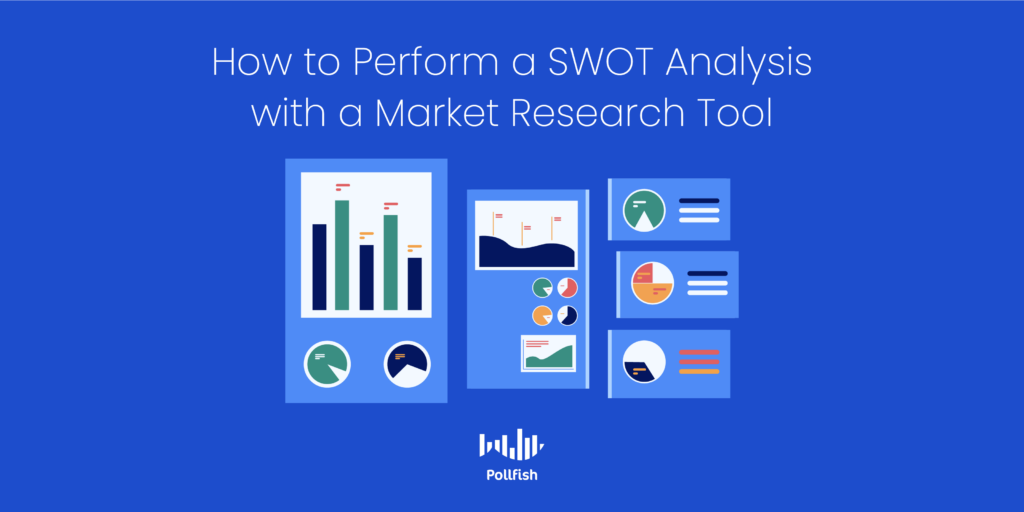
- First, create the SWOT Analysis matrix, made up of the four quadrants. The following image shows what it should look like.
- Next, determine the objective of your SWOT analysis.
- You should aim your SWOT analysis on a specific objective or campaign to reap value from it.
- For example, you could perform a SWOT analysis to help you decide if you should create a new product, change your CX or internal processes.
- Conduct secondary market research on your business, industry and market.
- Study trade magazines, news websites, industry sites, reports, blogs and even social media accounts pertaining to your industry.
- This includes studying your competitors through internet research and designated competitor research tools.
- Examine all the available resources that detail your customer buying behavior, preferences, lifestyles and more.
- Using the explanation and question examples in the section on strengths, list your business's strengths.
- These involve your financial resources, physical location, cost advantages, product features, brand visibility, customer experience, consumer loyalty and more.
- This also includes employee relations. This is where a market research tool comes in handy. This kind of tool allows you to understand how your workers view your business and can point out their problems, concerns and desires to determine your strengths and weaknesses.
- Conduct primary research on your employees with any of the following surveys:
- List your business's weaknesses. Use the above question examples and explanation as reference points.
- List things that you consider to be weaknesses, such as the things that put your business at a disadvantage when compared with others.
- They can include a lack of new products, customers, staff absenteeism, a lack of intellectual property, declining market share, distance to market and a low customer lifetime value (CLV) among your customers.
- Check on these for accuracy, given that, as time progresses, your weaknesses may change or dissipate.
- When you review your SWOT analysis after a year, your weaknesses may be resolved, a clear sign of progress.
- Survey your customers to detect any weaknesses. Using the following surveys:
- Product satisfaction survey
- Customer satisfaction score survey (CSAT survey)
- Customer effort score survey (CES survey)
- List the potential opportunities for your business. Refer to the above question examples.
- Consider different external opportunities for your business. These are not your internal strengths and are not definite.
- One opportunity for business could be a threat to another.
- Do not list the same item as both an opportunity and threat. You should weigh the benefits and drawbacks of a seeming opportunity before you can determine if it indeed is an opportunity or a threat.
- Opportunities include new technologies, training programs, partnerships, a diverse marketplace, new talent, new campaign ideas and a change of government policy.
- Survey your vendors and partners to discover opportunities with B2B surveys.
- Identify your target market with an online survey platform.
- Find cultural opportunities by using surveys to unlock cultural trends.
- Segment your target market via market segmentation with surveys.
- List the potential threats to your business. Refer to the above question examples.
- List all the external factors that could cause a problem for your business or threaten it in any way.
- Threats include high turnover, disgruntled workers, unsatisfied customers, rising unemployment, increasing competition, higher interest rates and the uncertainty of global markets.
- Discover any latent and overt threats by using a market research tool to create the following surveys:
- Establish priorities based on analyzing the SWOT matrix.
- Create 4 separate lists on each SWOT element.
- Display them side-by-side so you can have a clear visualization of how your business is running and all of its issues.
- Prioritize the most pressing issues along with categorizing those that can be dealt with later.
- Develop a strategy to address the issues in the SWOT.
- Review the foremost issues in each of the four elements.
- In order to work through and resolve the issues, consider the following questions:
- How can we overcome the threats we identified?
- How can we make the most of our opportunities?
- How can we use our strengths to take advantage of the opportunities identified?
- What do we need to do to overcome the weaknesses we identified to take advantage of the opportunities?
- How will we minimize our weaknesses to eliminate the identified threats?
- After you have contemplated these questions and came up with practical answers, use the SWOT analysis to develop strategies for achieving your goals.
- Don’t stop testing or conducting primary market research. Use your market research tool for A/B testing, sending personal surveys to exact targets via the Link Distribution Link feature and extracting any kind of customer information you need.
Supporting the SWOT and Beyond
A SWOT analysis is a strong tool that allows you to understand how your business is faring in your industry, while laying out external factors about your competitors and the industry at large. While you may offer competitive products and good prices, external factors will always affect your business.
In order to perform a SWOT analysis, generally stay informed on your customers and industry and remain competitive, you’ll need to conduct market research. Secondary research provides a useful starting point for studying all of your external factors, from your competitors to how others view your own business.
But it is primary research that will provide you with the most valuable insights. With a potent market research tool, you can easily gather all the insights you need about virtually any topic. A strong tool will make it easy to create and deploy surveys to your intended audience.
When you’re deciding on the best market research tool for your organization, seek one that offers a mobile-first platform, as the use of mobile devices dominates the digital space.
It should also include advanced skip logic to route respondents to relevant follow-up questions, use artificial intelligence and machine learning to automatically remove low-quality data, offer a broad range of filtering data options and engage respondents in their natural digital environments via random device engagement (RDE) sampling.
Most importantly, it should allow you to survey anyone. As such, you should opt for an online survey platform that deploys hundreds of millions of surveys to a wide network of digital publishers. Ideally, these are highly-trafficked websites and apps.
When you use an online survey platform with all of these capabilities, you’ll quickly obtain your data and extract only the highest quality of it to support the SWOT and any other analysis.
The Guide on How to Analyze a Market with Market Research Software
The Guide on How to Analyze a Market with Market Research Software
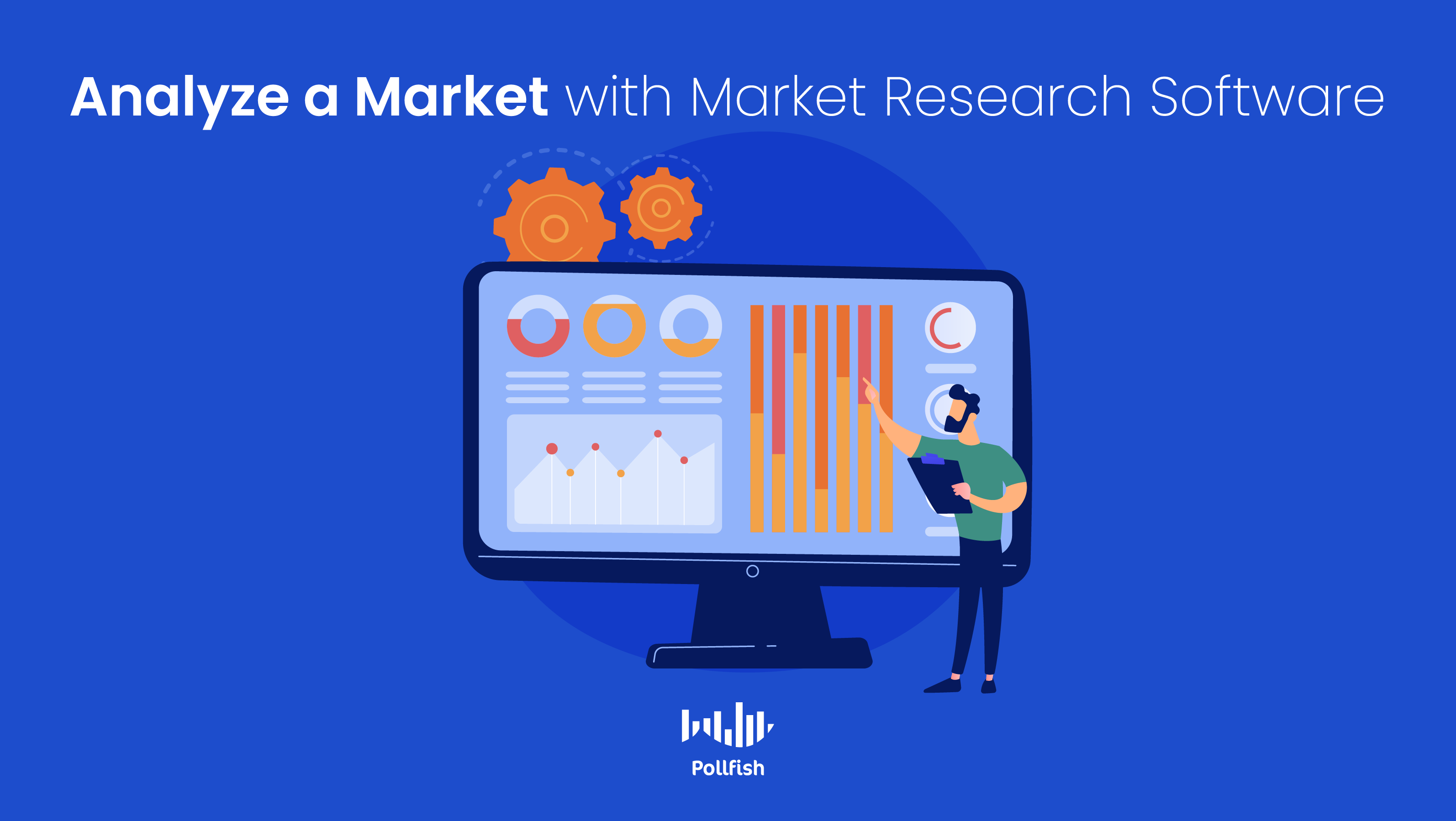
How to analyze a market is a legitimate business concern. After all, it would be unwise, if not downright dangerous to engage in any business operations without understanding the state of your market and all of its components.
With the plethora of insights available through secondary market research, it can be difficult to understand where to begin on conducting a market analysis. It is especially hard to cut through the noise when there are so many sources at your disposal.
Nonetheless, analyzing a market is critical for understanding how a business’s products and practices will exist in certain markets. It also brings insight into the heart of any business: the customers.
63% of consumers expect businesses to know their unique needs and expectations; 76% of B2B customers expect the same. Analyzing a market will shed light on consumers, along with the market at large.
This article is centered around how to analyze a market, the concept of market analysis and how to use market research software to strengthen your analysis.
Understanding the Concept of Market Analysis
A market analysis is a quantitative and qualitative assessment of a particular market.
It involves observing the size of a market both in volume and in value, various customer segments, customer buying behavior, the competition, the economic environment, such as barriers to entry and regulation, supply and demand and new markets.
A market analysis is designed to be a thorough assessment of a market within a specific industry. It also involves studying the external factors that will directly affect the growth of your business. To this end, it involves examining the market in relation to the aims of your own business.
With this analysis, you’ll look into the dynamics of your market and various critical components. A precise marketing analysis should include the following topics:
- The size of your target market
- Your main competitors, their offerings and marketing practices
- Your potential customers and their various segments and customer personas
- Your customer behavior
- Acceptable price points and ranges for your product for your target market
- Your competitors' strengths and weaknesses
- Industry barriers, rules and regulations
How to Analyze a Market
Analyzing your market is a multi-step process that you can benefit from if you conduct it correctly, which involves covering all areas of the market. While this may appear to be time-consuming and difficult, studying each factor at a time and following the process gradually will ease the process.
Additionally, there are various tools you can use to soothe the process, along with deriving valuable insights for your market analysis.
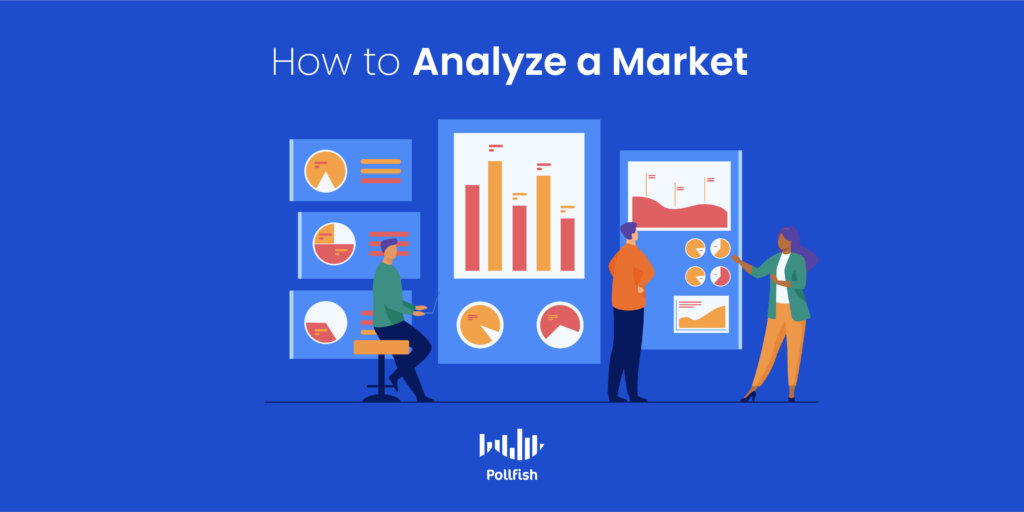
The following is a step-by-step guide on how to analyze a market. It will help if you seek how to do market research for a business plan, bolster your strategic planning process, use data for decision-making or generally validate any of your business actions.
- Determine the purpose of your analysis.
- While a market analysis is a comprehensive process, your business may be more in need of a particular analysis, which is where it should focus on.
- There are many purposes and sub-campaigns you can conduct for your analysis, such as: gauging your competition, understanding a new market, finding product innovations, being acquainted with laws and more.
- Determine your purpose as soon as possible, as it will guide your market analysis.
- Begin by deciding whether your purpose is internal, such as to improve your cash flow or business operations, or external, like gaining a business loan.
- Research the state of the industry.
- In this step, you’ll need to describe the state of your industry and where it’s headed.
- Use secondary resources to study its trends, size, projected growth, in-demand product and services and their innovations.
- Use secondary sources such as industry news sites, blogs, MarketResearch.com for industry reports, Ubersuggest for top industry players and SEO analyses and research associations such as Forrester.
- Identify your target market and segment it.
- This analysis will point you to your ideal customer(s).
- First, use some of the secondary research from Step 2, but to find the target market associated with your niche and business.
- You’ll need to understand your market size, who your customers are, where they live, their lifestyles and what might influence their buying decisions. Study the following factors:
- Age
- Gender
- Location
- Occupation
- Education
- Needs
- Interests
- Marital status
- Behaviors
- Views on current events, cultural trends, your industry, its competitors, etc.
- Next, segment your target market into smaller groups via market segmentation.
- Consider creating a customer profile or persona that represents your ideal customer to serve as a model for your business campaigns.
- Study your competition.
- You’ll need a strong grasp of your competitors, as this will ensure you can take advantage of their weaknesses, which you can then use to show your target market why your business is the better choice.
- Gather insights on both your direct and indirect competitors from the secondary research you conducted in a previous step.
- Study the following aspects of your competitors:
- Market saturation
- Market capitalization
- Strengths, weaknesses, advantages and hurdles
- It will be useful to conduct a SWOT analysis on several competitors.
- Establish how your competitors are different from your business. Note the strengths you have to prevent new companies from competing with you.
- For example, a better location, business patents, lower prices, a better rewards program
- Rank your competitors from least to most threatening and use this document when comparing yourself and innovating on new products, services and experiences.
- Conduct further analyses in relation to your business.
- Learn how to perform a SWOT analysis on your own business; use it and compare it with that of your competitors, especially the ones you’ve run such an analysis on in Step 4.
- Form more granular analyses on your market, economy and consumers by using these secondary resources:
- U.S. Bureau of Labor Statistics
- U.S. Census Bureau
- State and local commerce sites
- Trade journals
- Use an online survey platform to distribute surveys to members of your target market and gain their thoughts on the market, along with their needs, wants, shopping habits and more.
- Map out your own products and prices.
- Consider your price; is it on the lower or higher end of the price range in your niche, or is it somewhere in between?
- To this end, mull over the message that your price sends to your market at large.
- High prices are usually associated with quality. You’ll need to make sure that your marketing signifies that you offer a high-quality product or service if you intend on using high price points.
- High-priced goods and services need to come with a high-quality customer experience (CX).
- If your prices are lower on the spectrum, relay that in your marketing messages so that consumers will know you’re the low-priced brand.
- Forecast your initial sales volume.
- After you categorize your pricing and map out a pricing strategy, assess how much you expect to sell.
- Prior industry research will come into play in this step as you think about how much of the broader market you expect to capture.
- You’ll need to examine factors such as location, niche and your target market to understand how much they typically spend to predict your sales.
- Your forecast should be a realistic portion of the total spending in your particular niche. Be realistic, as you won’t gain 50% of the market during your first year.
- When you create your forecast, use it as a business goal. Compare your actual sales with your forecast.
- Tracking your progress will help you adjust your strategy accordingly and avoid sales disparities between your forecast and actual sales in the future.
- Consider your price; is it on the lower or higher end of the price range in your niche, or is it somewhere in between?
- Analyze your data.
- After you finish collecting all your relevant data and ensuring its accuracy, analyze it so that it is actionable to your company.
- Organize your research into distinct, digestible sections, especially in a way that is specific to your purpose, target market and competition.
- Use the following elements to organize your findings:
- An overview of your industry's size and growth rate
- Your business's projected market share percentage
- Customer buying trends
- An industry outlook
- Your forecasted growth
- How much customers are willing to pay for your products or service
- Act on your analysis.
- After putting the final touches on your market analysis, use your research and findings to take action on business.
- Use the intelligence of other businesses doing the things that you can implement in your business.
- Implement marketing strategies that you’ve found to be effective in your analysis.
- Test your analysis and form hypotheses that you can use for correlational, causal and experimental research, if need be.
- Take action on your findings by forming marketing, sales, PR and market research campaigns.
- Iterate different actions to see which garner the best results.
- Apply survey research for all your iterations and further research endeavors.
How to Analyze a Market with Market Research Software
Market research software carries plenty of weight beyond market research alone. In fact, it powers many of the activities within a market analysis. As such, you can apply it to virtually any of the steps in the previous section, as long as they are relevant to the topic at hand and you know the population to study.
This is because surveys bring you direct intelligence into your target population. They allow you to frame your own inquiries so that you gain the exact insights you’re seeking. They also provide a means of standing out from your competitors, giving you the added edge of studying virtually any demographic, should the online survey platform you use allow it.
As such, you’ll be powered with original insights which you can then apply to your content marketing strategy, your PR market research study and virtually all other areas in which you can put original insights to use. When it comes to properly executing business initiatives, you’ll find that most campaigns benefit from original survey data, given how much you can fine-tune your survey to your intelligence needs.
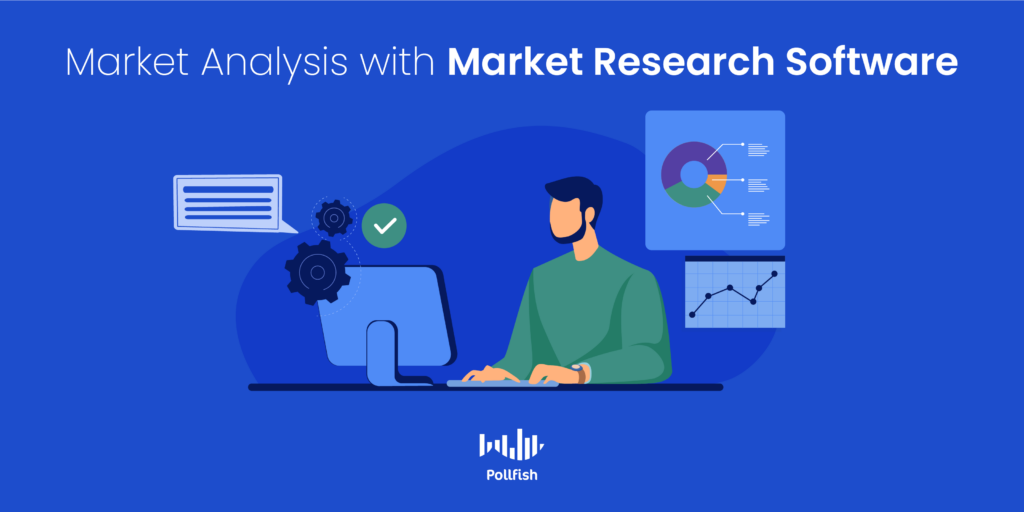
Then there’s the aspect of market research, the original space that makes use of survey software. Not to be confused with market analysis, market research focuses on studying a particular market with a focus on the customers in it. It is a major component of market analysis, however, as customers are the lifeblood of any business.
As a matter of fact, 52% of consumers (and 65% of B2B buyers) say they’re likely to switch brands if a business doesn’t personalize to them. Brands can only personalize to their target market effectively if they know who their customers are. This involves far more than greeting them by their name when they sign into a website. Businesses must be attuned to their behaviors, preferences, aversions and needs. Market research software such as an online survey platform is the ideal tool to use for tracking and using customer data.
Whenever you’re curious about moving forward with any business activity, whether it is forming a new product innovation, launching a product or producing an ad campaign, you can always rely on using surveys to put your ideas to the test.
An online survey platform provides you answers to any of your curiosities from your consumers themselves. However, a strong market research platform will grant you access to surveying anyone, from your customers, to your vendors, to your competitors.
Winning Over Your Market
Analyzing a market is no simple feat. However, by following the steps in this guide, you are set to form a data-rich market analysis. To reap the most quality market intelligence, you’ll need to use a strong online survey platform.
As aforementioned, this kind of market research software opens doors to a large swath of insights on virtually any aspect of your market analysis process. From customers to competitors and everyone else, a robust online survey platform facilitates your entire market analysis.
This kind of survey provider should offer an agile platform, one that can easily allow brands to engage in an agile research strategy. It should be a mobile-first platform, as the use of mobile devices dominates the digital space.
It should also include advanced skip logic to route respondents to relevant follow-up questions, use artificial intelligence and machine learning to automatically remove low-quality data, offer a broad range of filtering data options and engage respondents in their natural digital environments via random device engagement (RDE) sampling.
Most importantly, it should allow you to survey anyone. To achieve this powerful capability, you’ll need to opt for an online survey platform that deploys hundreds of millions of surveys to a wide network of digital publishers. Ideally, these are highly-trafficked websites and apps.
Additionally, to achieve this end, the platform should offer the Distribution Link feature, which allows researchers to send surveys to specific targets, as this feature is a link to a survey.
You have full access to all of these capabilities on the Pollfish market research platform, which will set you up for success in conducting a market analysis.
Avoiding Big Data Problems and Pitfalls
Avoiding Big Data Problems and Pitfalls

Big data problems pervade market research despite the technological advances that enhance and simplify access to consumer data. As such, big data incurs various difficulties.
This is because the many types of Martech and SaaS solutions designed for market research yield massive quantities of data. Many times, this data is of no use to organizations. On the contrary, large pools of data hamper progress.
While a whopping 90% of companies say that data is key to their organization, only 3% of company respondents say they are able to act on all of the customer data they collect.
Many businesses have caught up already implementing big data, along with AI, as 97.2% of organizations invest in AI and big data. 95% of businesses say that managing unstructured data is a problem for their business.
Big data is undoubtedly a source of contention for many businesses, including the kind that provides market research. Despite its many conveniences, big data carries various issues.
This article expounds on big data problems, their implications and how to avoid them using the correct market research techniques and online survey software.
Understanding Big Data
Before delving into big data problems, you should first understand the meaning of big data. As its name implies, this term refers to the large volume of structured and unstructured data that overloads a business on a daily basis.
Big data is composed of larger, more complex sets of data, especially from new data sources. These ample data sets are often too big for traditional data processing software. Or, when they aren’t, they are still too large and complex for a business’s personnel to fully process.
When data meets “big data” status within a business, it has reached the point of being unmanageable. Although these massive volumes of data can be used to address and resolve other business problems you wouldn’t have been able to before, their sheer volume is the root of the problem.
As such, businesses struggle with big data, often leading them to render the data that they wind up collecting as unwieldy and, in the worst case, useless.
The Three V’s of Big Data
There’s more to the concept of big data aside from the high-level notion of voluminous data sets that are difficult to access and understand. There is also more to this concept than the fleshed-out definition of the previous section.
To understand the makeup of big data, you must understand its three main factors, called the Three V’s of Big Data. These represent the following:
- Volume
- Big data entails high volumes of low-density, unstructured (and sometimes structured) data. This can include data with unknown value, such as Twitter data feeds, clickstreams on a site page or a mobile app, or sensor-enabled equipment. This can equate to terabytes of data for some companies or hundreds of petabytes for others.
- Velocity
- Velocity refers to the quick rate at which data is received and acted upon. Typically, high-velocity data goes directly to memory instead of being written to disk. There are certain internet-enabled smart products that work in either real-time or near real-time that will require real-time evaluation and action on this.
- Variety
- This involves the many kinds of data available to an organization. Unlike in traditional data, big data types are usually unstructured, whereas transitional data sets are structured and neatly fit in a relational database. Big data also includes semistructured data types, such as audio, video and text. This requires additional preprocessing to obtain meaning and support metadata.
Understanding Big Data Problems
Big data problems involve a wide variety of issues that spring from big data and its nuances. To tackle these problems properly, you must first be aware of them and how they can affect your business.
While some of these problems involve the nature of the data itself, others deal with how the data is perceived, along with how workers engage with it. As such, these problems are typically twofold in nature, stemming from either the big data features or the way that they are dealt with.
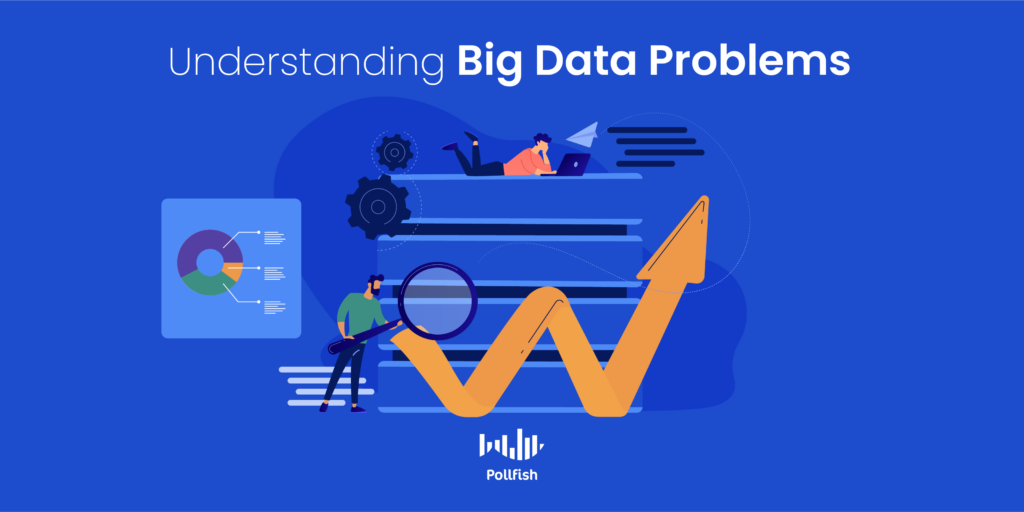
The following considers both of these kinds of big data problems:
Internal Big Data Challenges
These challenges originate from big data and its source. As such, they often deal with the features and capabilities of big data and its operating system.
- Inaccurate Data: Possibly the biggest detriment to your data, inaccurate data renders all campaigns void, whether it is a marketing email drip campaign, an ABM campaign, or a survey campaign. Accuracy is the strength in any campaign, as it will prevent workers from sending messages to the wrong people, along with reeling in the wrong consumer info, the kind that defeats the purpose of market research, which is to understand your target market at a closer level.
- Lack of Integration: Not all sources of data are designed to be integrated with other systems. This is a major problem, as it creates data silos, thereby averting teams from accessing different data sets and projects simultaneously. It becomes exceedingly difficult to interpret different data sets when they cannot be integrated. As such, data silos keep much of the data unused.
- Unorganized: Scores of big data that belong to one source are plagued by disorganization. Whether it is in the way it is stored or presented, a lack of organization makes big data difficult to read and evaluate, forestalling the use of any data for decision-making efforts. In turn, this slows down any actions that businesses could have otherwise taken based on the use of big data.
- Imprecise: While big data can be insightful and information-rich, it offers little value when it is imprecise. This means the customer insights are either too vague or lack data filtering options. For example, your big data platform may have imprecisely targeted your target market or its particular segments. It may also offer few options when it comes to filtering pre or post-results data.
External Big Data Challenges
These challenges usually result from the internal challenges of big data. However, they can also originate in purely external ways, meaning how workers and other users react to it and engage with it.
- Lack of proper data understanding: This often deals with accurate data being evaluated improperly, which yields incorrect findings and actions thereof. Employees may not understand the significance of their data, how to organize it or what to make of it. They can also simply misinterpret it. This is more common with big data given its vast amount and variety.
- Faulty Data Storage: Storing large sets of data correctly is a major external challenge, especially as it increases with the progression of time and campaigns. This makes it extremely difficult to handle this data, let alone fully assess it and put it to actionable use. Given that most of the big data is unstructured and comes from various sources such as documents, videos, audios, text files and more, you cannot find it in databases.
- Confusion with Data Tool Selection: Whether it comes from choosing between platforms, or features within one tool, confusion over these key choices can easily arise.
- Securing the big data: Securing a massive set of data is not only challenging, but a lack of it leads to data breaches, a dangerous and costly repercussion for businesses. Unfortunately, many companies are too busy to understand, store and analyze their data that they delay data security until later stages. This leaves the data in unprotected repositories that hackers can easily take advantage of.
- Lack of data professionals: Many companies simply lack data professionals, whether they are data scientists, analysts, engineers or IT professionals. This leaves companies with workers who lack the experience in working with hefty data sets. This can be problemsome even with the emergence of data handling tools, as some employees simply don’t have the aptitude for dealing with data.
- Slow acclimation: Not all big data providers offer platforms inclined toward the democratization of data. As such, this creates slower acclimation across teams, given that only a select few employees learn how to use the data. This also contributes to silos, which impede acclimation to the new team projects and actions taken after certain workers have analyzed the data.
The Importance of Avoiding Big Data Problems
Given the many utilities that big data offers, it is important to steer clear of big data problems. When you evade these problems, you can reap the benefits of big data to its fullest advantage. Essentially, the more big data problems your company circumvents, the greater your benefits will be.
Here are some of the foremost benefits that big data offers for market research and general business purposes:
- Machine learning and AI:
- Streamlines operations, removes fraud from research, reduces manual labor
- Not all big data providers implement AI and machine learning in their systems.
- Product development:
- Big data provides insights on demographics and their relation to and opinions on products.
- It helps build predictive models for new products by classifying the key features of past and current products and comparing the relationship between those attributes and the products’ commercial success.
- Innovation:
- Big data can help you determine new ways to use your insights to drive innovations. For example, using data for financial considerations.
- It helps discover trends that can inspire new ideas for products and experiences.
- Operational Efficiency:
- With big data, you can analyze and evaluate production, customer feedback and returns, which anticipate future demands and reduce outages.
- It can be used to improve decision-making in line with current market demand.
- Customer Experience:
- Companies compete on CX every bit as much as they do on the products themselves. Big data aids all CX decisions with critical customer insights.
- Big data allows you to correctly perform marketing personalization, a crucial strategy that removes the monotony from marketing and shows customers that you pay attention to their needs and preferences.
How Proper Market Research Solutions Ward Off Big Data Problems
Using the correct market research solution will ward off big data problems. This is why it is important to use a provider that offers features that ward off big data problems. First off, a strong market research platform, such as an online survey tool should offer various means of data visualizations and exports.
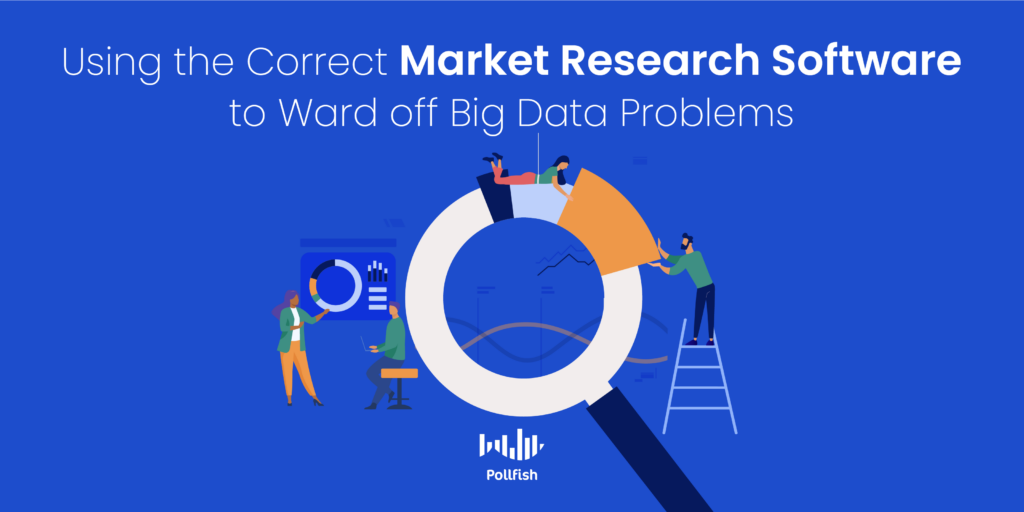
This makes the data far more accessible for various team members to view and analyze. It also provides more options to group the data differently for the purpose of conducting different analyses.
Along with accessibility, this kind of platform should offer an advanced data filtering system, the kind that allows researchers to neatly organize and view only the bits of data most relevant to their study. A strong data filtering system allows researchers to filter data across the entire platform.
For example, this includes filtering options in the screener, the questionnaire and the post-survey data results. This is especially useful to ward off big data problems, as it removes irrelevant data from view, along with irrelevant segments of the population from taking part in the study.
With this capability, researchers do not have to confront massive sets of irrelevant data, or even the kind that does not perfectly align with what they are currently studying.
In addition, this kind of platform should use a variety of mechanisms that constantly perform quality checks that protect against survey fraud. These mechanisms include bot removal, disqualifying respondents on a VPN, checking carrier consistency, testing whether respondents are paying attention, eliminating survey fraud and much more. These kinds of mechanisms remove low-quality data, eradicating various kinds of survey bias from your research.
Such a platform should cut through the noise of big data by offering extremely user-friendly interfaces, the kind that makes it possible to make your own survey in just three quick steps. After all, to scale back on big data, you would need a simplified interface.
Making the Most of Your Data
The data that you can extract from market research is a commodity in a competitive market, whether you operate a startup or a long-established business. Readily accessible consumer data allows market researchers to form large data sets to mine for all kinds of consumer insights.
However, large sets of data often hamper any market research progress, as they yield various big data problems, from inaccurate data to imprecise information, to unorganized data presentations and more.
Sampling size alone does not establish a quality set of data, nor does it reduce big data problems. As such, there is far more than the amount of collected data that makes for a strong market research project. The most important factor for reducing big data problems and conducting a strong market research campaign is the market research platform you use to conduct your research and extract the data.
A strong online survey platform offers all of the capabilities aforementioned in the previous section, along with being agile and offering a mobile-first platform, as mobile use dominates the digital space. It should engage respondents in their natural digital environments via random device engagement (RDE) sampling, as this too reduces biases.
When market researchers use such an online survey platform, they are equipped with tackling and avoiding big data problems.











